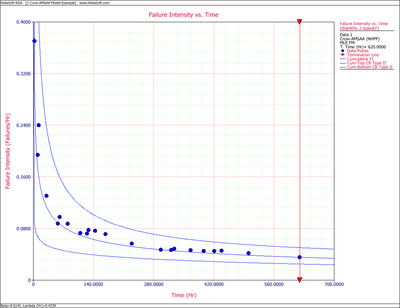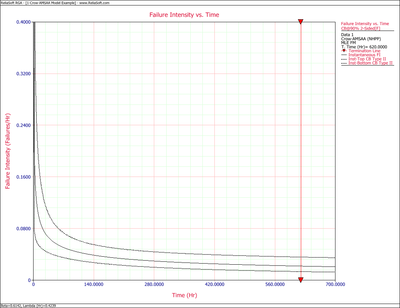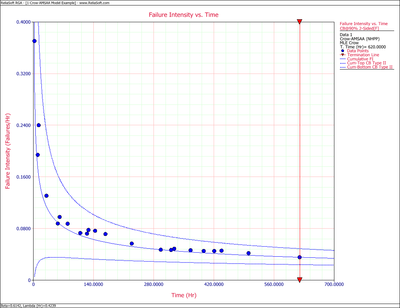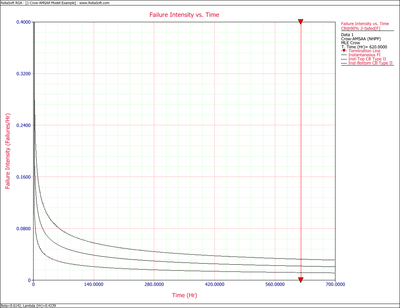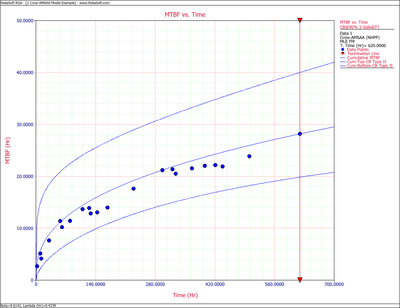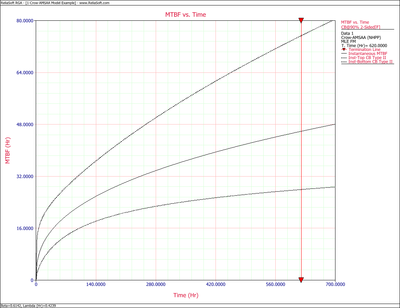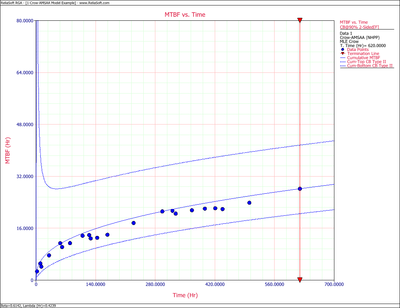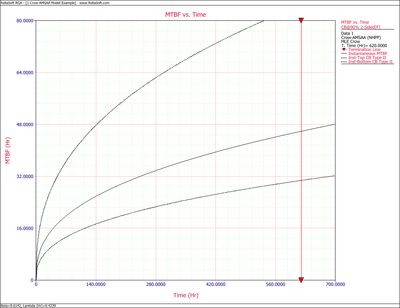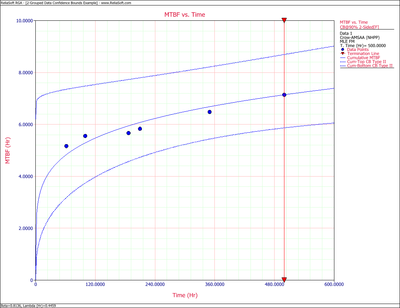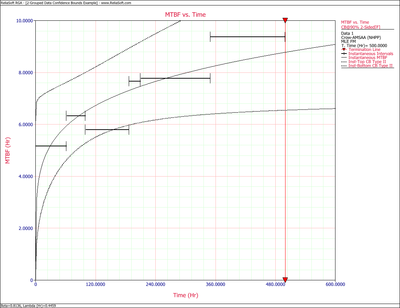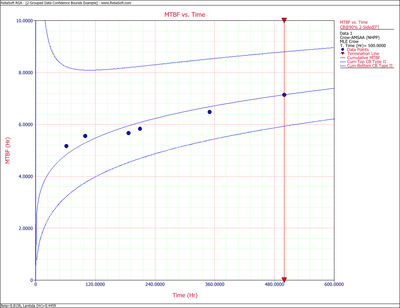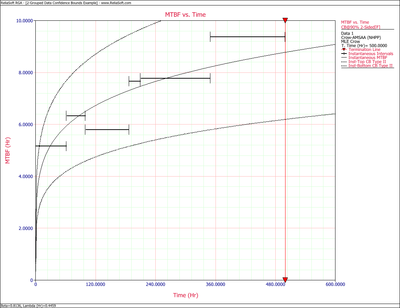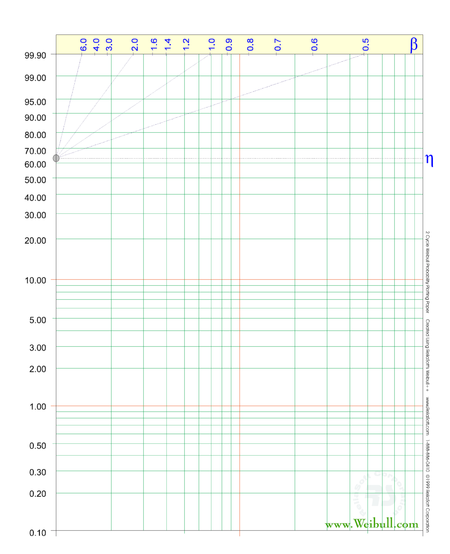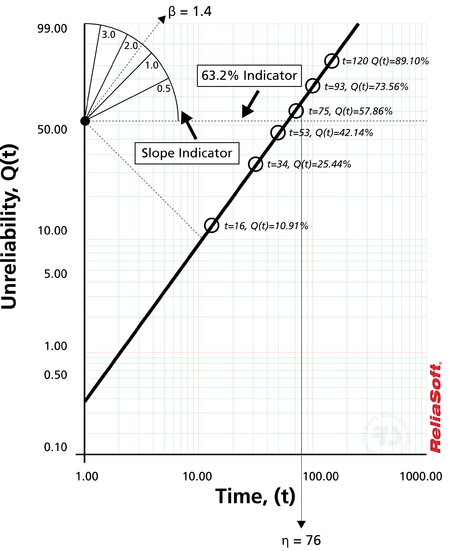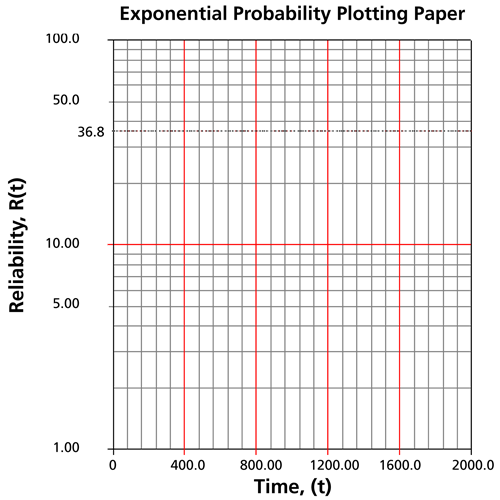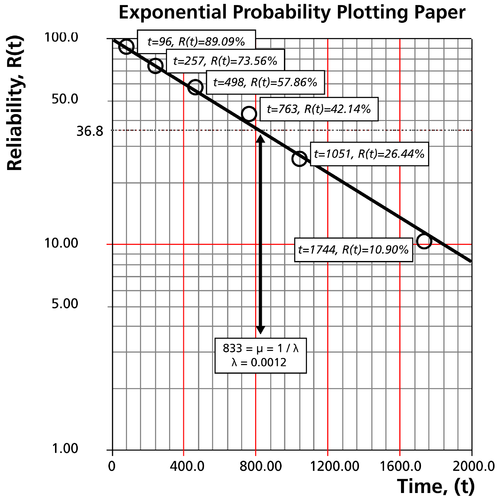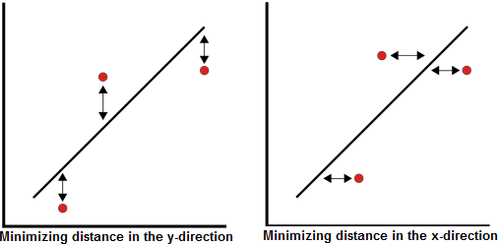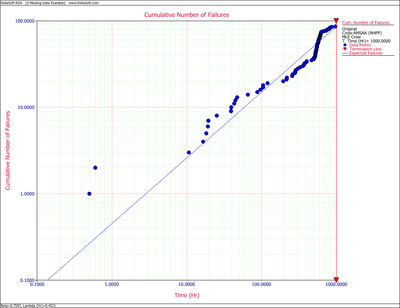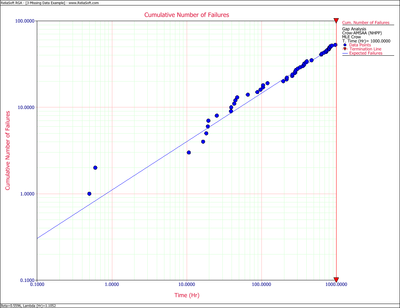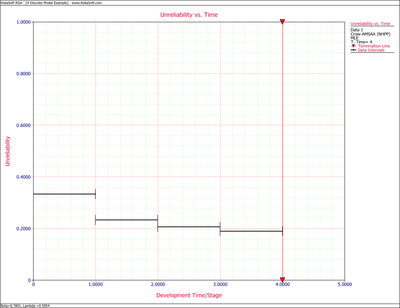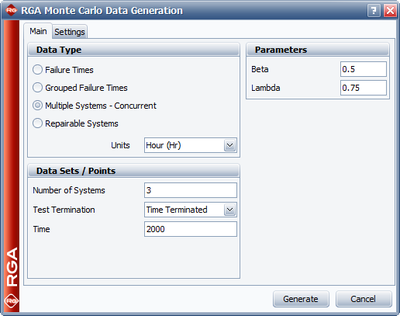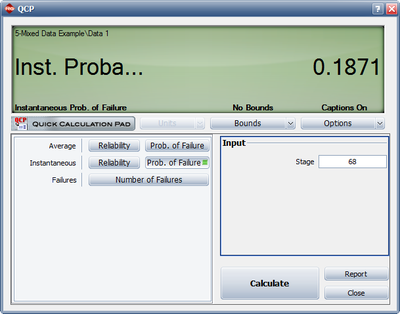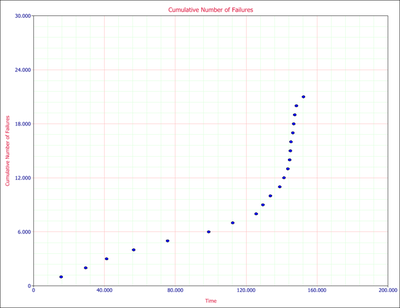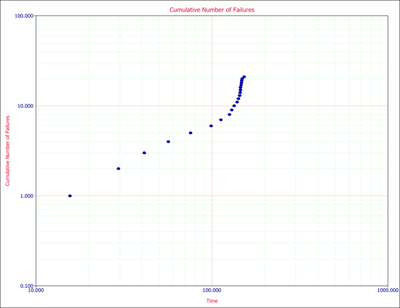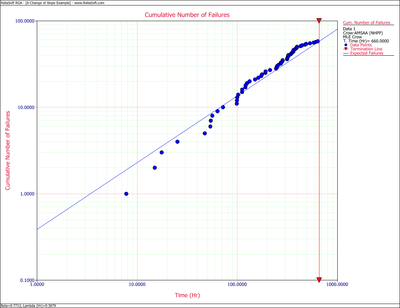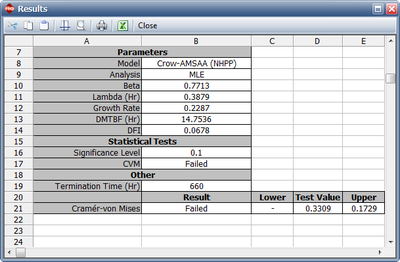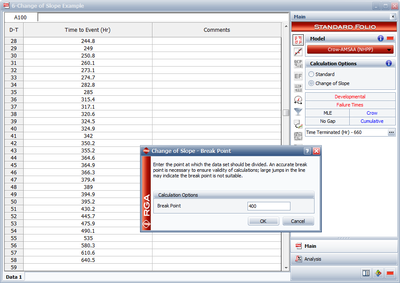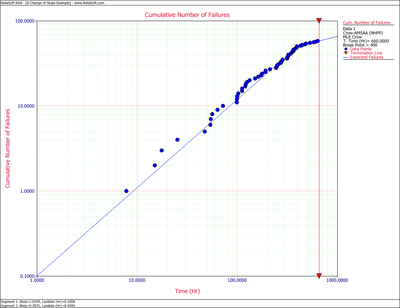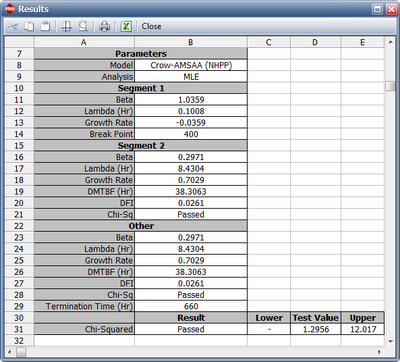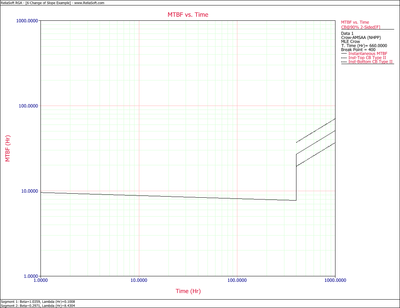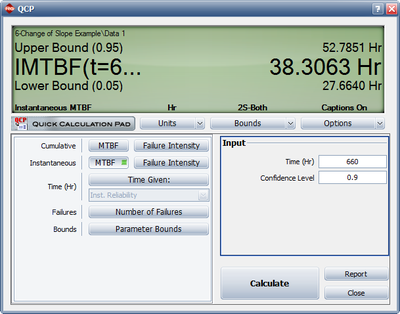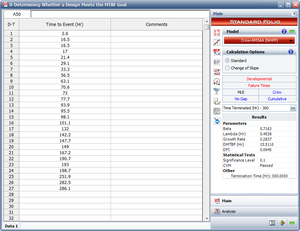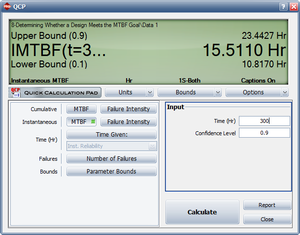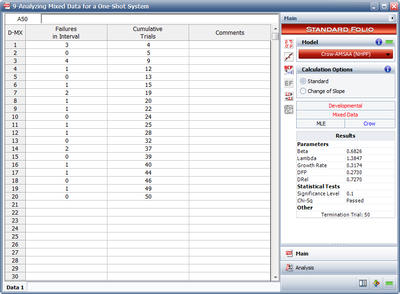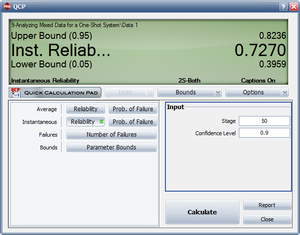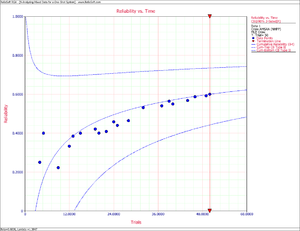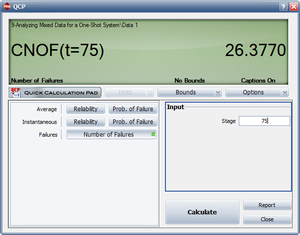Crow-AMSAA (NHPP)
Dr. Larry H. Crow [17] noted that the Duane Model could be stochastically represented as a Weibull process, allowing for statistical procedures to be used in the application of this model in reliability growth. This statistical extension became what is known as the Crow-AMSAA (NHPP) model. This method was first developed at the U.S. Army Materiel Systems Analysis Activity (AMSAA). It is frequently used on systems when usage is measured on a continuous scale. It can also be applied for the analysis of one shot items when there is high reliability and a large number of trials.
Test programs are generally conducted on a phase by phase basis. The Crow-AMSAA model is designed for tracking the reliability within a test phase and not across test phases. A development testing program may consist of several separate test phases. If corrective actions are introduced during a particular test phase, then this type of testing and the associated data are appropriate for analysis by the Crow-AMSAA model. The model analyzes the reliability growth progress within each test phase and can aid in determining the following:
- Reliability of the configuration currently on test
- Reliability of the configuration on test at the end of the test phase
- Expected reliability if the test time for the phase is extended
- Growth rate
- Confidence intervals
- Applicable goodness-of-fit tests
Crow-AMSAA (NHPP) Model
The reliability growth pattern for the Crow-AMSAA model is exactly the same pattern as for the Duane postulate, that is, the cumulative number of failures is linear when plotted on ln-ln scale. Unlike the Duane postulate, the Crow-AMSAA model is statistically based. Under the Duane postulate, the failure rate is linear on ln-ln scale. However, for the Crow-AMSAA model statistical structure, the failure intensity of the underlying non-homogeneous Poisson process (NHPP) is linear when plotted on ln-ln scale.
Let [math]\displaystyle{ N(t)\,\! }[/math] be the cumulative number of failures observed in cumulative test time [math]\displaystyle{ t\,\! }[/math], and let [math]\displaystyle{ \rho (t)\,\! }[/math] be the failure intensity for the Crow-AMSAA model. Under the NHPP model, [math]\displaystyle{ \rho (t)\Delta t\,\! }[/math] is approximately the probably of a failure occurring over the interval [math]\displaystyle{ [t,t+\Delta t]\,\! }[/math] for small [math]\displaystyle{ \Delta t\,\! }[/math]. In addition, the expected number of failures experienced over the test interval [math]\displaystyle{ [0,T]\,\! }[/math] under the Crow-AMSAA model is given by:
- [math]\displaystyle{ E[N(T)]=\mathop{}_{0}^{T}\rho (t)dt\,\! }[/math]
The Crow-AMSAA model assumes that [math]\displaystyle{ \rho (T)\,\! }[/math] may be approximated by the Weibull failure rate function:
- [math]\displaystyle{ \rho (T)=\frac{\beta }{{{\eta }^{\beta }}}{{T}^{\beta -1}}\,\! }[/math]
Therefore, if [math]\displaystyle{ \lambda =\tfrac{1}{{{\eta }^{\beta }}},\,\! }[/math] the intensity function, [math]\displaystyle{ \rho (T),\,\! }[/math] or the instantaneous failure intensity, [math]\displaystyle{ {{\lambda }_{i}}(T)\,\! }[/math], is defined as:
- [math]\displaystyle{ {{\lambda }_{i}}(T)=\lambda \beta {{T}^{\beta -1}},\text{with }T\gt 0,\text{ }\lambda \gt 0\text{ and }\beta \gt 0\,\! }[/math]
In the special case of exponential failure times, there is no growth and the failure intensity, [math]\displaystyle{ \rho (t)\,\! }[/math], is equal to [math]\displaystyle{ \lambda \,\! }[/math]. In this case, the expected number of failures is given by:
- [math]\displaystyle{ \begin{align} E[N(T)]= & \mathop{}_{0}^{T}\rho (t)dt \\ = & \lambda T \end{align}\,\! }[/math]
In order for the plot to be linear when plotted on ln-ln scale under the general reliability growth case, the following must hold true where the expected number of failures is equal to:
- [math]\displaystyle{ \begin{align} E[N(T)]= & \mathop{}_{0}^{T}\rho (t)dt \\ = & \lambda {{T}^{\beta }} \end{align}\,\! }[/math]
To put a statistical structure on the reliability growth process, consider again the special case of no growth. In this case the number of failures, [math]\displaystyle{ N(T),\,\! }[/math] experienced during the testing over [math]\displaystyle{ [0,T]\,\! }[/math] is random. The expected number of failures, [math]\displaystyle{ N(T),\,\! }[/math] is said to follow the homogeneous (constant) Poisson process with mean [math]\displaystyle{ \lambda T\,\! }[/math] and is given by:
- [math]\displaystyle{ \underset{}{\overset{}{\mathop{\Pr }}}\,[N(T)=n]=\frac{{{(\lambda T)}^{n}}{{e}^{-\lambda T}}}{n!};\text{ }n=0,1,2,\ldots \,\! }[/math]
The Crow-AMSAA model generalizes this no growth case to allow for reliability growth due to corrective actions. This generalization keeps the Poisson distribution for the number of failures but allows for the expected number of failures, [math]\displaystyle{ E[N(T)],\,\! }[/math] to be linear when plotted on ln-ln scale. The Crow-AMSAA model lets [math]\displaystyle{ E[N(T)]=\lambda {{T}^{\beta }}\,\! }[/math]. The probability that the number of failures, [math]\displaystyle{ N(T),\,\! }[/math] will be equal to [math]\displaystyle{ n\,\! }[/math] under growth is then given by the Poisson distribution:
- [math]\displaystyle{ \underset{}{\overset{}{\mathop{\Pr }}}\,[N(T)=n]=\frac{{{(\lambda {{T}^{\beta }})}^{n}}{{e}^{-\lambda {{T}^{\beta }}}}}{n!};\text{ }n=0,1,2,\ldots \,\! }[/math]
This is the general growth situation, and the number of failures, [math]\displaystyle{ N(T)\,\! }[/math], follows a non-homogeneous Poisson process. The exponential, "no growth" homogeneous Poisson process is a special case of the non-homogeneous Crow-AMSAA model. This is reflected in the Crow-AMSAA model parameter where [math]\displaystyle{ \beta =1\,\! }[/math].
The cumulative failure rate, [math]\displaystyle{ {{\lambda }_{c}}\,\! }[/math], is:
- [math]\displaystyle{ \begin{align} {{\lambda }_{c}}=\lambda {{T}^{\beta -1}} \end{align}\,\! }[/math]
The cumulative [math]\displaystyle{ MTB{{F}_{c}}\,\! }[/math] is:
- [math]\displaystyle{ MTB{{F}_{c}}=\frac{1}{\lambda }{{T}^{1-\beta }}\,\! }[/math]
As mentioned above, the local pattern for reliability growth within a test phase is the same as the growth pattern observed by Duane. The Duane [math]\displaystyle{ MTB{{F}_{c}}\,\! }[/math] is equal to:
- [math]\displaystyle{ MTB{{F}_{{{c}_{DUANE}}}}=b{{T}^{\alpha }}\,\! }[/math]
And the Duane cumulative failure rate, [math]\displaystyle{ {{\lambda }_{c}}\,\! }[/math], is:
- [math]\displaystyle{ {{\lambda }_{{{c}_{DUANE}}}}=\frac{1}{b}{{T}^{-\alpha }}\,\! }[/math]
Thus a relationship between Crow-AMSAA parameters and Duane parameters can be developed, such that:
- [math]\displaystyle{ \begin{align} {{b}_{DUANE}}= & \frac{1}{{{\lambda }_{AMSAA}}} \\ {{\alpha }_{DUANE}}= & 1-{{\beta }_{AMSAA}} \end{align}\,\! }[/math]
Note that these relationships are not absolute. They change according to how the parameters (slopes, intercepts, etc.) are defined when the analysis of the data is performed. For the exponential case, [math]\displaystyle{ \beta =1\,\! }[/math], then [math]\displaystyle{ {{\lambda }_{i}}(T)=\lambda \,\! }[/math], a constant. For [math]\displaystyle{ \beta \gt 1\,\! }[/math], [math]\displaystyle{ {{\lambda }_{i}}(T)\,\! }[/math] is increasing. This indicates a deterioration in system reliability. For [math]\displaystyle{ \beta \lt 1\,\! }[/math], [math]\displaystyle{ {{\lambda }_{i}}(T)\,\! }[/math] is decreasing. This is indicative of reliability growth. Note that the model assumes a Poisson process with the Weibull intensity function, not the Weibull distribution. Therefore, statistical procedures for the Weibull distribution do not apply for this model. The parameter [math]\displaystyle{ \lambda \,\! }[/math] is called a scale parameter because it depends upon the unit of measurement chosen for [math]\displaystyle{ T\,\! }[/math], while [math]\displaystyle{ \beta \,\! }[/math] is the shape parameter that characterizes the shape of the graph of the intensity function.
The total number of failures, [math]\displaystyle{ N(T)\,\! }[/math], is a random variable with Poisson distribution. Therefore, the probability that exactly [math]\displaystyle{ n\,\! }[/math] failures occur by time [math]\displaystyle{ T\,\! }[/math] is:
- [math]\displaystyle{ P[N(T)=n]=\frac{{{[\theta (T)]}^{n}}{{e}^{-\theta (T)}}}{n!}\,\! }[/math]
The number of failures occurring in the interval from [math]\displaystyle{ {{T}_{1}}\,\! }[/math] to [math]\displaystyle{ {{T}_{2}}\,\! }[/math] is a random variable having a Poisson distribution with mean:
- [math]\displaystyle{ \theta ({{T}_{2}})-\theta ({{T}_{1}})=\lambda (T_{2}^{\beta }-T_{1}^{\beta })\,\! }[/math]
The number of failures in any interval is statistically independent of the number of failures in any interval that does not overlap the first interval. At time [math]\displaystyle{ {{T}_{0}}\,\! }[/math], the failure intensity is [math]\displaystyle{ {{\lambda }_{i}}({{T}_{0}})=\lambda \beta T_{0}^{\beta -1}\,\! }[/math]. If improvements are not made to the system after time [math]\displaystyle{ {{T}_{0}}\,\! }[/math], it is assumed that failures would continue to occur at the constant rate [math]\displaystyle{ {{\lambda }_{i}}({{T}_{0}})=\lambda \beta T_{0}^{\beta -1}\,\! }[/math]. Future failures would then follow an exponential distribution with mean [math]\displaystyle{ m({{T}_{0}})=\tfrac{1}{\lambda \beta T_{0}^{\beta -1}}\,\! }[/math]. The instantaneous MTBF of the system at time [math]\displaystyle{ T\,\! }[/math] is:
- [math]\displaystyle{ m(T)=\frac{1}{\lambda \beta {{T}^{\beta -1}}}\,\! }[/math]
Note About Applicability
The Duane and Crow-AMSAA models are the most frequently used reliability growth models. Their relationship comes from the fact that both make use of the underlying observed linear relationship between the logarithm of cumulative MTBF and cumulative test time. However, the Duane model does not provide a capability to test whether the change in MTBF observed over time is significantly different from what might be seen due to random error between phases. The Crow-AMSAA model allows for such assessments. Also, the Crow-AMSAA allows for development of hypothesis testing procedures to determine growth presence in the data (where [math]\displaystyle{ \beta \lt 1\,\! }[/math] indicates that there is growth in MTBF, [math]\displaystyle{ \beta =1\,\! }[/math] indicates a constant MTBF and [math]\displaystyle{ \beta \gt 1\,\! }[/math] indicates a decreasing MTBF). Additionally, the Crow-AMSAA model views the process of reliability growth as probabilistic, while the Duane model views the process as deterministic.
Parameter Estimation
Maximum Likelihood Estimators
The probability density function (pdf) of the [math]\displaystyle{ {{i}^{th}}\,\! }[/math] event given that the [math]\displaystyle{ {{(i-1)}^{th}}\,\! }[/math] event occurred at [math]\displaystyle{ {{T}_{i-1}}\,\! }[/math] is:
- [math]\displaystyle{ f({{T}_{i}}|{{T}_{i-1}})=\frac{\beta }{\eta }{{\left( \frac{{{T}_{i}}}{\eta } \right)}^{\beta -1}}\cdot {{e}^{-\tfrac{1}{{{\eta }^{\beta }}}\left( T_{i}^{\beta }-T_{i-1}^{\beta } \right)}}\,\! }[/math]
The likelihood function is:
- [math]\displaystyle{ L={{\lambda }^{n}}{{\beta }^{n}}{{e}^{-\lambda {{T}^{*\beta }}}}\underset{i=1}{\overset{n}{\mathop \prod }}\,T_{i}^{\beta -1}\,\! }[/math]
where [math]\displaystyle{ {{T}^{*}}\,\! }[/math] is the termination time and is given by:
- [math]\displaystyle{ {{T}^{*}}=\left\{ \begin{matrix} {{T}_{n}}\text{ if the test is failure terminated} \\ T\gt {{T}_{n}}\text{ if the test is time terminated} \\ \end{matrix} \right\}\,\! }[/math]
Taking the natural log on both sides:
- [math]\displaystyle{ \Lambda =n\ln \lambda +n\ln \beta -\lambda {{T}^{*\beta }}+(\beta -1)\underset{i=1}{\overset{n}{\mathop \sum }}\,\ln {{T}_{i}}\,\! }[/math]
And differentiating with respect to [math]\displaystyle{ \lambda \,\! }[/math] yields:
- [math]\displaystyle{ \frac{\partial \Lambda }{\partial \lambda }=\frac{n}{\lambda }-{{T}^{*\beta }}\,\! }[/math]
Set equal to zero and solve for [math]\displaystyle{ \lambda \,\! }[/math] :
- [math]\displaystyle{ \widehat{\lambda }=\frac{n}{{{T}^{*\beta }}}\,\! }[/math]
Now differentiate with respect to [math]\displaystyle{ \beta \,\! }[/math] :
- [math]\displaystyle{ \frac{\partial \Lambda }{\partial \beta }=\frac{n}{\beta }-\lambda {{T}^{*\beta }}\ln {{T}^{*}}+\underset{i=1}{\overset{n}{\mathop \sum }}\,\ln {{T}_{i}}\,\! }[/math]
Set equal to zero and solve for [math]\displaystyle{ \beta \,\! }[/math] :
- [math]\displaystyle{ \widehat{\beta }=\frac{n}{n\ln {{T}^{*}}-\underset{i=1}{\overset{n}{\mathop{\sum }}}\,\ln {{T}_{i}}}\,\! }[/math]
Biasing and Unbiasing of Beta
The equation above returns the biased estimate of [math]\displaystyle{ \beta \,\! }[/math]. The unbiased estimate of [math]\displaystyle{ \beta \,\! }[/math] can be calculated by using the following relationships. For time terminated data (meaning that the test ends after a specified number of failures):
- [math]\displaystyle{ \bar{\beta }=\frac{N-1}{N}\hat{\beta }\,\! }[/math]
For failure terminated data (meaning that the test ends after a specified test time):
- [math]\displaystyle{ \bar{\beta }=\frac{N-2}{N}\hat{\beta }\,\! }[/math]
Crow-AMSAA Model Example
Two prototypes of a system were tested simultaneously with design changes incorporated during the test. The following table presents the data collected over the entire test. Find the Crow-AMSAA parameters and the intensity function using maximum likelihood estimators.
| Failure Number | Failed Unit | Test Time Unit 1(hours) | Test Time Unit 2(hours) | Total Test Time(hours) | [math]\displaystyle{ ln{(T)}\,\! }[/math] |
|---|---|---|---|---|---|
| 1 | 1 | 1.0 | 1.7 | 2.7 | 0.99325 |
| 2 | 1 | 7.3 | 3.0 | 10.3 | 2.33214 |
| 3 | 2 | 8.7 | 3.8 | 12.5 | 2.52573 |
| 4 | 2 | 23.3 | 7.3 | 30.6 | 3.42100 |
| 5 | 2 | 46.4 | 10.6 | 57.0 | 4.04305 |
| 6 | 1 | 50.1 | 11.2 | 61.3 | 4.11578 |
| 7 | 1 | 57.8 | 22.2 | 80.0 | 4.38203 |
| 8 | 2 | 82.1 | 27.4 | 109.5 | 4.69592 |
| 9 | 2 | 86.6 | 38.4 | 125.0 | 4.82831 |
| 10 | 1 | 87.0 | 41.6 | 128.6 | 4.85671 |
| 11 | 2 | 98.7 | 45.1 | 143.8 | 4.96842 |
| 12 | 1 | 102.2 | 65.7 | 167.9 | 5.12337 |
| 13 | 1 | 139.2 | 90.0 | 229.2 | 5.43459 |
| 14 | 1 | 166.6 | 130.1 | 296.7 | 5.69272 |
| 15 | 2 | 180.8 | 139.8 | 320.6 | 5.77019 |
| 16 | 1 | 181.3 | 146.9 | 328.2 | 5.79362 |
| 17 | 2 | 207.9 | 158.3 | 366.2 | 5.90318 |
| 18 | 2 | 209.8 | 186.9 | 396.7 | 5.98318 |
| 19 | 2 | 226.9 | 194.2 | 421.1 | 6.04287 |
| 20 | 1 | 232.2 | 206.0 | 438.2 | 6.08268 |
| 21 | 2 | 267.5 | 233.7 | 501.2 | 6.21701 |
| 22 | 2 | 330.1 | 289.9 | 620.0 | 6.42972 |
Solution
For the failure terminated test, [math]\displaystyle{ {\beta}\,\! }[/math] is:
- [math]\displaystyle{ \begin{align} \widehat{\beta }&=\frac{n}{n\ln {{T}^{*}}-\underset{i=1}{\overset{n}{\mathop{\sum }}}\,\ln {{T}_{i}}} \\ &=\frac{22}{22\ln 620-\underset{i=1}{\overset{22}{\mathop{\sum }}}\,\ln {{T}_{i}}} \\ \end{align}\,\! }[/math]
- where:
- [math]\displaystyle{ \underset{i=1}{\overset{22}{\mathop \sum }}\,\ln {{T}_{i}}=105.6355\,\! }[/math]
- Then:
- [math]\displaystyle{ \widehat{\beta }=\frac{22}{22\ln 620-105.6355}=0.6142\,\! }[/math]
And for [math]\displaystyle{ {\lambda}\,\! }[/math] :
- [math]\displaystyle{ \begin{align} \widehat{\lambda }&=\frac{n}{{{T}^{*\beta }}} \\ & =\frac{22}{{{620}^{0.6142}}}=0.4239 \\ \end{align}\,\! }[/math]
Therefore, [math]\displaystyle{ {{\lambda }_{i}}(T)\,\! }[/math] becomes:
- [math]\displaystyle{ \begin{align} {{\widehat{\lambda }}_{i}}(T)= & 0.4239\cdot 0.6142\cdot {{620}^{-0.3858}} \\ = & 0.0217906\frac{\text{failures}}{\text{hr}} \end{align}\,\! }[/math]
The next figure shows the plot of the failure rate. If no further changes are made, the estimated MTBF is [math]\displaystyle{ \tfrac{1}{0.0217906}\,\! }[/math] or 46 hours.
Confidence Bounds
The RGA software provides two methods to estimate the confidence bounds for the Crow Extended model when applied to developmental testing data. The Fisher Matrix approach is based on the Fisher Information Matrix and is commonly employed in the reliability field. The Crow bounds were developed by Dr. Larry Crow. See the Crow-AMSAA Confidence Bounds chapter for details on how the confidence bounds are calculated.
Confidence Bounds Example
Calculate the 90% 2-sided confidence bounds on the cumulative and instantaneous failure intensity for the data from the Crow-AMSAA Model Example given above.
Solution
Fisher Matrix Bounds
Using [math]\displaystyle{ \widehat{\beta }\,\! }[/math] and [math]\displaystyle{ \widehat{\lambda }\,\! }[/math] estimated in the Crow-AMSAA example, the Fisher Matrix bounds on beta are:
- [math]\displaystyle{ \begin{align} \frac{{{\partial }^{2}}\Lambda }{\partial {{\lambda }^{2}}} = & -\frac{22}{{{0.4239}^{2}}}=-122.43 \\ \frac{{{\partial }^{2}}\Lambda }{\partial {{\beta }^{2}}} = & -\frac{22}{{{0.6142}^{2}}}-0.4239\cdot {{620}^{0.6142}}{{(\ln 620)}^{2}}=-967.68 \\ \frac{{{\partial }^{2}}\Lambda }{\partial \lambda \partial \beta } = & -{{620}^{0.6142}}\ln 620=-333.64 \end{align}\,\! }[/math]
The Fisher Matrix then becomes:
- [math]\displaystyle{ \begin{align} \begin{bmatrix}122.43 & 333.64\\ 333.64 & 967.68\end{bmatrix}^{-1} & = \begin{bmatrix}Var(\hat{\lambda}) & Cov(\hat{\beta},\hat{\lambda})\\ Cov(\hat{\beta},\hat{\lambda}) & Var(\hat{\beta})\end{bmatrix} \\ & = \begin{bmatrix} 0.13519969 & -0.046614609\\ -0.046614609 & 0.017105343 \end{bmatrix} \end{align}\,\! }[/math]
For [math]\displaystyle{ T=620\,\! }[/math] hours, the partial derivatives of the cumulative and instantaneous failure intensities are:
- [math]\displaystyle{ \begin{align} \frac{\partial {{\lambda }_{c}}(T)}{\partial \beta }= & \widehat{\lambda }{{T}^{\widehat{\beta }-1}}\ln (T) \\ = & 0.4239\cdot {{620}^{-0.3858}}\ln 620 \\ = & 0.22811336 \\ \frac{\partial {{\lambda }_{c}}(T)}{\partial \lambda }= & {{T}^{\widehat{\beta }-1}} \\ = & {{620}^{-0.3858}} \\ = & 0.083694185 \end{align}\,\! }[/math]
- [math]\displaystyle{ \begin{align} \frac{\partial {{\lambda }_{i}}(T)}{\partial \beta }= & \widehat{\lambda }{{T}^{\widehat{\beta }-1}}+\widehat{\lambda }\widehat{\beta }{{T}^{\widehat{\beta }-1}}\ln T \\ = & 0.4239\cdot {{620}^{-0.3858}}+0.4239\cdot 0.6142\cdot {{620}^{-0.3858}}\ln 620 \\ = & 0.17558519 \end{align}\,\! }[/math]
- [math]\displaystyle{ \begin{align} \frac{\partial {{\lambda }_{i}}(T)}{\partial \lambda }= & \widehat{\beta }{{T}^{\widehat{\beta }-1}} \\ = & 0.6142\cdot {{620}^{-0.3858}} \\ = & 0.051404969 \end{align}\,\! }[/math]
Therefore, the variances become:
- [math]\displaystyle{ \begin{align} Var(\hat{\lambda_{c}}(T)) & = 0.22811336^{2}\cdot 0.017105343\ + 0.083694185^{2} \cdot 0.13519969\ -2\cdot 0.22811336\cdot 0.083694185\cdot 0.046614609 \\ & = 0.00005721408 \\ Var(\hat{\lambda_{i}}(T)) & = 0.17558519^{2}\cdot 0.01715343\ + 0.051404969^{2}\cdot 0.13519969\ -2\cdot 0.17558519\cdot 0.051404969\cdot 0.046614609 \\ &= 0.0000431393 \end{align}\,\! }[/math]
The cumulative and instantaneous failure intensities at [math]\displaystyle{ T=620\,\! }[/math] hours are:
- [math]\displaystyle{ \begin{align} {{\lambda }_{c}}(T)= & 0.03548 \\ {{\lambda }_{i}}(T)= & 0.02179 \end{align}\,\! }[/math]
So, at the 90% confidence level and for [math]\displaystyle{ T=620\,\! }[/math] hours, the Fisher Matrix confidence bounds for the cumulative failure intensity are:
- [math]\displaystyle{ \begin{align} {{[{{\lambda }_{c}}(T)]}_{L}}= & 0.02499 \\ {{[{{\lambda }_{c}}(T)]}_{U}}= & 0.05039 \end{align}\,\! }[/math]
The confidence bounds for the instantaneous failure intensity are:
- [math]\displaystyle{ \begin{align} {{[{{\lambda }_{i}}(T)]}_{L}}= & 0.01327 \\ {{[{{\lambda }_{i}}(T)]}_{U}}= & 0.03579 \end{align}\,\! }[/math]
The following figures display plots of the Fisher Matrix confidence bounds for the cumulative and instantaneous failure intensity, respectively.
Crow Bounds
The Crow confidence bounds for the cumulative failure intensity at the 90% confidence level and for [math]\displaystyle{ T=620\,\! }[/math] hours are:
- [math]\displaystyle{ \begin{align} {{[{{\lambda }_{c}}(T)]}_{L}} = & \frac{\chi _{\tfrac{\alpha }{2},2N}^{2}}{2\cdot t} \\ = & \frac{29.787476}{2*620} \\ = & 0.02402 \\ {{[{{\lambda }_{c}}(T)]}_{U}} = & \frac{\chi _{1-\tfrac{\alpha }{2},2N+2}^{2}}{2\cdot t} \\ = & \frac{62.8296}{2*620} \\ = & 0.05067 \end{align}\,\! }[/math]
The Crow confidence bounds for the instantaneous failure intensity at the 90% confidence level and for [math]\displaystyle{ T=620\,\! }[/math] hours are:
- [math]\displaystyle{ \begin{align} {{[{{\lambda }_{i}}(t)]}_{L}} = & \frac{1}{{{[MTB{{F}_{i}}]}_{U}}} \\ = & \frac{1}{MTB{{F}_{i}}\cdot U} \\ = & 0.01179 \end{align}\,\! }[/math]
- [math]\displaystyle{ \begin{align} {{[{{\lambda }_{i}}(t)]}_{U}}= & \frac{1}{{{[MTB{{F}_{i}}]}_{L}}} \\ = & \frac{1}{MTB{{F}_{i}}\cdot L} \\ = & 0.03253 \end{align}\,\! }[/math]
The following figures display plots of the Crow confidence bounds for the cumulative and instantaneous failure intensity, respectively.
Another Confidence Bounds Example
Calculate the confidence bounds on the cumulative and instantaneous MTBF for the data from the Crow-AMSAA Model Example given above.
Solution
Fisher Matrix Bounds
From the previous example:
- [math]\displaystyle{ \begin{align} Var(\widehat{\lambda }) = & 0.13519969 \\ Var(\widehat{\beta }) = & 0.017105343 \\ Cov(\widehat{\beta },\widehat{\lambda }) = & -0.046614609 \end{align}\,\! }[/math]
And for [math]\displaystyle{ T=620\,\! }[/math] hours, the partial derivatives of the cumulative and instantaneous MTBF are:
- [math]\displaystyle{ \begin{align} \frac{\partial {{m}_{c}}(T)}{\partial \beta }= & -\frac{1}{\widehat{\lambda }}{{T}^{1-\widehat{\beta }}}\ln T \\ = & -\frac{1}{0.4239}{{620}^{0.3858}}\ln 620 \\ = & -181.23135 \\ \frac{\partial {{m}_{c}}(T)}{\partial \lambda } = & -\frac{1}{{{\widehat{\lambda }}^{2}}}{{T}^{1-\widehat{\beta }}} \\ = & -\frac{1}{{{0.4239}^{2}}}{{620}^{0.3858}} \\ = & -66.493299 \\ \frac{\partial {{m}_{i}}(T)}{\partial \beta } = & -\frac{1}{\widehat{\lambda }{{\widehat{\beta }}^{2}}}{{T}^{1-\beta }}-\frac{1}{\widehat{\lambda }\widehat{\beta }}{{T}^{1-\widehat{\beta }}}\ln T \\ = & -\frac{1}{0.4239\cdot {{0.6142}^{2}}}{{620}^{0.3858}}-\frac{1}{0.4239\cdot 0.6142}{{620}^{0.3858}}\ln 620 \\ = & -369.78634 \\ \frac{\partial {{m}_{i}}(T)}{\partial \lambda } = & -\frac{1}{{{\widehat{\lambda }}^{2}}\widehat{\beta }}{{T}^{1-\widehat{\beta }}} \\ = & -\frac{1}{{{0.4239}^{2}}\cdot 0.6142}\cdot {{620}^{0.3858}} \\ = & -108.26001 \end{align}\,\! }[/math]
Therefore, the variances become:
- [math]\displaystyle{ \begin{align} Var({{\widehat{m}}_{c}}(T)) = & {{\left( -181.23135 \right)}^{2}}\cdot 0.017105343+{{\left( -66.493299 \right)}^{2}}\cdot 0.13519969 \\ & -2\cdot \left( -181.23135 \right)\cdot \left( -66.493299 \right)\cdot 0.046614609 \\ = & 36.113376 \end{align}\,\! }[/math]
- [math]\displaystyle{ \begin{align} Var({{\widehat{m}}_{i}}(T)) = & {{\left( -369.78634 \right)}^{2}}\cdot 0.017105343+{{\left( -108.26001 \right)}^{2}}\cdot 0.13519969 \\ & -2\cdot \left( -369.78634 \right)\cdot \left( -108.26001 \right)\cdot 0.046614609 \\ = & 191.33709 \end{align}\,\! }[/math]
So, at 90% confidence level and [math]\displaystyle{ T=620\,\! }[/math] hours, the Fisher Matrix confidence bounds are:
- [math]\displaystyle{ \begin{align} {{[{{m}_{c}}(T)]}_{L}} = & {{{\hat{m}}}_{c}}(t){{e}^{-{{z}_{\alpha }}\sqrt{Var({{{\hat{m}}}_{c}}(t))}/{{{\hat{m}}}_{c}}(t)}} \\ = & 19.84581 \\ {{[{{m}_{c}}(T)]}_{U}} = & {{{\hat{m}}}_{c}}(t){{e}^{{{z}_{\alpha }}\sqrt{Var({{{\hat{m}}}_{c}}(t))}/{{{\hat{m}}}_{c}}(t)}} \\ = & 40.01927 \end{align}\,\! }[/math]
- [math]\displaystyle{ \begin{align} {{[{{m}_{i}}(T)]}_{L}} = & {{{\hat{m}}}_{i}}(t){{e}^{-{{z}_{\alpha }}\sqrt{Var({{{\hat{m}}}_{i}}(t))}/{{{\hat{m}}}_{i}}(t)}} \\ = & 27.94261 \\ {{[{{m}_{i}}(T)]}_{U}} = & {{{\hat{m}}}_{i}}(t){{e}^{{{z}_{\alpha }}\sqrt{Var({{{\hat{m}}}_{i}}(t))}/{{{\hat{m}}}_{i}}(t)}} \\ = & 75.34193 \end{align}\,\! }[/math]
The following two figures show plots of the Fisher Matrix confidence bounds for the cumulative and instantaneous MTBFs.
Crow Bounds
The Crow confidence bounds for the cumulative MTBF and the instantaneous MTBF at the 90% confidence level and for [math]\displaystyle{ T=620\,\! }[/math] hours are:
- [math]\displaystyle{ \begin{align} {{[{{m}_{c}}(T)]}_{L}} = & \frac{1}{{{[{{\lambda }_{c}}(T)]}_{U}}} \\ = & 20.5023 \\ {{[{{m}_{c}}(T)]}_{U}} = & \frac{1}{{{[{{\lambda }_{c}}(T)]}_{L}}} \\ = & 41.6282 \end{align}\,\! }[/math]
- [math]\displaystyle{ \begin{align} {{[MTB{{F}_{i}}]}_{L}} = & MTB{{F}_{i}}\cdot {{\Pi }_{1}} \\ = & 30.7445 \\ {{[MTB{{F}_{i}}]}_{U}} = & MTB{{F}_{i}}\cdot {{\Pi }_{2}} \\ = & 84.7972 \end{align}\,\! }[/math]
The figures below show plots of the Crow confidence bounds for the cumulative and instantaneous MTBF.
Confidence bounds can also be obtained on the parameters [math]\displaystyle{ \widehat{\beta }\,\! }[/math] and [math]\displaystyle{ \widehat{\lambda }\,\! }[/math]. For Fisher Matrix confidence bounds:
- [math]\displaystyle{ \begin{align} {{\beta }_{L}} = & \hat{\beta }{{e}^{{{z}_{\alpha }}\sqrt{Var(\hat{\beta })}/\hat{\beta }}} \\ = & 0.4325 \\ {{\beta }_{U}} = & \hat{\beta }{{e}^{-{{z}_{\alpha }}\sqrt{Var(\hat{\beta })}/\hat{\beta }}} \\ = & 0.8722 \end{align}\,\! }[/math]
- and:
- [math]\displaystyle{ \begin{align} {{\lambda }_{L}} = & \hat{\lambda }{{e}^{{{z}_{\alpha }}\sqrt{Var(\hat{\lambda })}/\hat{\lambda }}} \\ = & 0.1016 \\ {{\lambda }_{U}} = & \hat{\lambda }{{e}^{-{{z}_{\alpha }}\sqrt{Var(\hat{\lambda })}/\hat{\lambda }}} \\ = & 1.7691 \end{align}\,\! }[/math]
For Crow confidence bounds:
- [math]\displaystyle{ \begin{align} {{\beta }_{L}}= & 0.4527 \\ {{\beta }_{U}}= & 0.9350 \end{align}\,\! }[/math]
- and:
- [math]\displaystyle{ \begin{align} {{\lambda }_{L}}= & 0.2870 \\ {{\lambda }_{U}}= & 0.5827 \end{align}\,\! }[/math]
Grouped Data
For analyzing grouped data, we follow the same logic described previously for the Duane model. If the [math]\displaystyle{ E[N(T)]\,\! }[/math] equation from the Crow-AMSAA (NHPP) Model section above is linearized:
- [math]\displaystyle{ \begin{align} \ln [E(N(T))]=\ln \lambda +\beta \ln T \end{align}\,\! }[/math]
According to Crow [9], the likelihood function for the grouped data case, (where [math]\displaystyle{ {{n}_{1}},\,\! }[/math] [math]\displaystyle{ {{n}_{2}},\,\! }[/math] [math]\displaystyle{ {{n}_{3}},\ldots ,\,\! }[/math] [math]\displaystyle{ {{n}_{k}}\,\! }[/math] failures are observed and [math]\displaystyle{ k\,\! }[/math] is the number of groups), is:
- [math]\displaystyle{ \underset{i=1}{\overset{k}{\mathop \prod }}\,\underset{}{\overset{}{\mathop{\Pr }}}\,({{N}_{i}}={{n}_{i}})=\underset{i=1}{\overset{k}{\mathop \prod }}\,\frac{{{(\lambda T_{i}^{\beta }-\lambda T_{i-1}^{\beta })}^{{{n}_{i}}}}\cdot {{e}^{-(\lambda T_{i}^{\beta }-\lambda T_{i-1}^{\beta })}}}{{{n}_{i}}!}\,\! }[/math]
And the MLE of [math]\displaystyle{ \lambda \,\! }[/math] based on this relationship is:
- [math]\displaystyle{ \widehat{\lambda }=\frac{n}{T_{k}^{\widehat{\beta }}}\,\! }[/math]
where [math]\displaystyle{ n \,\! }[/math] is the total number of failures from all the groups.
The estimate of [math]\displaystyle{ \beta \,\! }[/math] is the value [math]\displaystyle{ \widehat{\beta }\,\! }[/math] that satisfies:
- [math]\displaystyle{ \underset{i=1}{\overset{k}{\mathop \sum }}\,{{n}_{i}}\left[ \frac{T_{i}^{\widehat{\beta }}\ln {{T}_{i}}-T_{i-1}^{\widehat{\beta }}\ln {{T}_{i-1}}}{T_{i}^{\widehat{\beta }}-T_{i-1}^{\widehat{\beta }}}-\ln {{T}_{k}} \right]=0\,\! }[/math]
See the Crow-AMSAA Confidence Bounds for details on how confidence bounds for grouped data are calculated.
Grouped Data Example
Consider the grouped failure times data given in the following table. Solve for the Crow-AMSAA parameters using MLE.
| Run Number | Cumulative Failures | End Time(hours) | [math]\displaystyle{ \ln{(T_i)}\,\! }[/math] | [math]\displaystyle{ \ln{(T_i)^2}\,\! }[/math] | [math]\displaystyle{ \ln{(\theta_i)}\,\! }[/math] | [math]\displaystyle{ \ln{(T_i)}\cdot\ln{(\theta_i)}\,\! }[/math] |
|---|---|---|---|---|---|---|
| 1 | 2 | 200 | 5.298 | 28.072 | 0.693 | 3.673 |
| 2 | 3 | 400 | 5.991 | 35.898 | 1.099 | 6.582 |
| 3 | 4 | 600 | 6.397 | 40.921 | 1.386 | 8.868 |
| 4 | 11 | 3000 | 8.006 | 64.102 | 2.398 | 19.198 |
| Sum = | 25.693 | 168.992 | 5.576 | 38.321 |
Solution
Using RGA, the value of [math]\displaystyle{ \widehat{\beta }\,\! }[/math], which must be solved numerically, is 0.6315. Using this value, the estimator of [math]\displaystyle{ \lambda \,\! }[/math] is:
- [math]\displaystyle{ \begin{align} \widehat{\lambda } = & \frac{11}{3,{{000}^{0.6315}}} \\ = & 0.0701 \end{align}\,\! }[/math]
Therefore, the intensity function becomes:
- [math]\displaystyle{ \widehat{\rho }(T)=0.0701\cdot 0.6315\cdot {{T}^{-0.3685}}\,\! }[/math]
Grouped Data Confidence Bounds Example
A new helicopter system is under development. System failure data has been collected on five helicopters during the final test phase. The actual failure times cannot be determined since the failures are not discovered until after the helicopters are brought into the maintenance area. However, total flying hours are known when the helicopters are brought in for service, and every 2 weeks each helicopter undergoes a thorough inspection to uncover any failures that may have occurred since the last inspection. Therefore, the cumulative total number of flight hours and the cumulative total number of failures for the 5 helicopters are known for each 2-week period. The total number of flight hours from the test phase is 500, which was accrued over a period of 12 weeks (six 2-week intervals). For each 2-week interval, the total number of flight hours and total number of failures for the 5 helicopters were recorded. The grouped data set is displayed in the following table.
| Interval | Interval Length | Failures in Interval |
|---|---|---|
| 1 | 0 - 62 | 12 |
| 2 | 62 -100 | 6 |
| 3 | 100 - 187 | 15 |
| 4 | 187 - 210 | 3 |
| 5 | 210 - 350 | 18 |
| 6 | 350 - 500 | 16 |
- 1) Estimate the parameters of the Crow-AMSAA model using maximum likelihood estimation.
- 2) Calculate the confidence bounds on the cumulative and instantaneous MTBF using the Fisher Matrix and Crow methods.
Solution
- 1) Using RGA, the value of [math]\displaystyle{ \widehat{\beta }\,\! }[/math], which must be solved numerically, is 0.81361. Using this value, [math]\displaystyle{ \widehat{\lambda }\,\! }[/math] is:
- [math]\displaystyle{ \widehat{\lambda }=0.44585\,\! }[/math]
The grouped Fisher Matrix confidence bounds can be obtained on the parameters [math]\displaystyle{ \widehat{\beta }\,\! }[/math] and [math]\displaystyle{ \widehat{\lambda }\,\! }[/math] at the 90% confidence level by:
- [math]\displaystyle{ \begin{align} {{\beta }_{L}} = & \hat{\beta }{{e}^{{{z}_{\alpha }}\sqrt{Var(\hat{\beta })}/\hat{\beta }}} \\ = & 0.6546 \\ {{\beta }_{U}} = & \hat{\beta }{{e}^{-{{z}_{\alpha }}\sqrt{Var(\hat{\beta })}/\hat{\beta }}} \\ = & 1.0112 \end{align}\,\! }[/math]
- and:
- [math]\displaystyle{ \begin{align} {{\lambda }_{L}} = & \hat{\lambda }{{e}^{{{z}_{\alpha }}\sqrt{Var(\hat{\lambda })}/\hat{\lambda }}} \\ = & 0.14594 \\ {{\lambda }_{U}} = & \hat{\lambda }{{e}^{-{{z}_{\alpha }}\sqrt{Var(\hat{\lambda })}/\hat{\lambda }}} \\ = & 1.36207 \end{align}\,\! }[/math]
Crow confidence bounds can also be obtained on the parameters [math]\displaystyle{ \widehat{\beta }\,\! }[/math] and [math]\displaystyle{ \widehat{\lambda }\,\! }[/math] at the 90% confidence level, as:
- [math]\displaystyle{ \begin{align} {{\beta }_{L}} = & \hat{\beta }(1-S) \\ = & 0.63552 \\ {{\beta }_{U}} = & \hat{\beta }(1+S) \\ = & 0.99170 \end{align}\,\! }[/math]
- and:
- [math]\displaystyle{ \begin{align} {{\lambda }_{L}} = & \frac{\chi _{\tfrac{\alpha }{2},2N}^{2}}{2\cdot T_{k}^{\beta }} \\ = & 0.36197 \\ {{\lambda }_{U}} = & \frac{\chi _{1-\tfrac{\alpha }{2},2N+2}^{2}}{2\cdot T_{k}^{\beta }} \\ = & 0.53697 \end{align}\,\! }[/math]
- 2) The Fisher Matrix confidence bounds for the cumulative MTBF and the instantaneous MTBF at the 90% 2-sided confidence level and for [math]\displaystyle{ T=500\,\! }[/math] hour are:
- [math]\displaystyle{ \begin{align} {{[{{m}_{c}}(T)]}_{L}} = & {{{\hat{m}}}_{c}}(t){{e}^{{{z}_{\alpha /2}}\sqrt{Var({{{\hat{m}}}_{c}}(t))}/{{{\hat{m}}}_{c}}(t)}} \\ = & 5.8680 \\ {{[{{m}_{c}}(T)]}_{U}} = & {{{\hat{m}}}_{c}}(t){{e}^{-{{z}_{\alpha /2}}\sqrt{Var({{{\hat{m}}}_{c}}(t))}/{{{\hat{m}}}_{c}}(t)}} \\ = & 8.6947 \end{align}\,\! }[/math]
- and:
- [math]\displaystyle{ \begin{align} {{[MTB{{F}_{i}}]}_{L}} = & {{{\hat{m}}}_{i}}(t){{e}^{{{z}_{\alpha /2}}\sqrt{Var({{{\hat{m}}}_{i}}(t))}/{{{\hat{m}}}_{i}}(t)}} \\ = & 6.6483 \\ {{[MTB{{F}_{i}}]}_{U}} = & {{{\hat{m}}}_{i}}(t){{e}^{-{{z}_{\alpha /2}}\sqrt{Var({{{\hat{m}}}_{i}}(t))}/{{{\hat{m}}}_{i}}(t)}} \\ = & 11.5932 \end{align}\,\! }[/math]
The next two figures show plots of the Fisher Matrix confidence bounds for the cumulative and instantaneous MTBF.
The Crow confidence bounds for the cumulative and instantaneous MTBF at the 90% 2-sided confidence level and for [math]\displaystyle{ T = 500\,\! }[/math]hours are:
- [math]\displaystyle{ \begin{align} {{[{{m}_{c}}(T)]}_{L}} = & \frac{1}{C{{(t)}_{U}}} \\ = & 5.85449 \\ {{[{{m}_{c}}(T)]}_{U}} = & \frac{1}{C{{(t)}_{L}}} \\ = & 8.79822 \end{align}\,\! }[/math]
- and:
- [math]\displaystyle{ \begin{align} {{[MTB{{F}_{i}}]}_{L}} = & {{\widehat{m}}_{i}}(1-W) \\ = & 6.19623 \\ {{[MTB{{F}_{i}}]}_{U}} = & {{\widehat{m}}_{i}}(1+W) \\ = & 11.36223 \end{align}\,\! }[/math]
The next two figures show plots of the Crow confidence bounds for the cumulative and instantaneous MTBF.
Goodness-of-Fit Tests
The term parameter estimation refers to the process of using sample data (in reliability engineering, usually times-to-failure or success data) to estimate the parameters of the selected distribution. Several parameter estimation methods are available. This section presents an overview of the available methods used in life data analysis. More specifically, we start with the relatively simple method of Probability Plotting and continue with the more sophisticated methods of Rank Regression (or Least Squares), Maximum Likelihood Estimation and Bayesian Estimation Methods.
Probability Plotting
The least mathematically intensive method for parameter estimation is the method of probability plotting. As the term implies, probability plotting involves a physical plot of the data on specially constructed probability plotting paper. This method is easily implemented by hand, given that one can obtain the appropriate probability plotting paper.
The method of probability plotting takes the cdf of the distribution and attempts to linearize it by employing a specially constructed paper. The following sections illustrate the steps in this method using the 2-parameter Weibull distribution as an example. This includes:
- Linearize the unreliability function
- Construct the probability plotting paper
- Determine the X and Y positions of the plot points
And then using the plot to read any particular time or reliability/unreliability value of interest.
Linearizing the Unreliability Function
In the case of the 2-parameter Weibull, the cdf (also the unreliability [math]\displaystyle{ Q(t)\,\! }[/math]) is given by:
- [math]\displaystyle{ F(t)=Q(t)=1-{e^{-\left(\tfrac{t}{\eta}\right)^{\beta}}}\,\! }[/math]
This function can then be linearized (i.e., put in the common form of [math]\displaystyle{ y = m'x + b\,\! }[/math] format) as follows:
- [math]\displaystyle{ \begin{align} Q(t)= & 1-{e^{-\left(\tfrac{t}{\eta}\right)^{\beta}}} \\ \ln (1-Q(t))= & \ln \left[ {e^{-\left(\tfrac{t}{\eta}\right)^{\beta}}} \right] \\ \ln (1-Q(t))=& -\left(\tfrac{t}{\eta}\right)^{\beta} \\ \ln ( -\ln (1-Q(t)))= & \beta \left(\ln \left( \frac{t}{\eta }\right)\right) \\ \ln \left( \ln \left( \frac{1}{1-Q(t)}\right) \right) = & \beta\ln{ t} -\beta\ln{\eta} \\ \end{align}\,\! }[/math]
Then by setting:
- [math]\displaystyle{ y=\ln \left( \ln \left( \frac{1}{1-Q(t)} \right) \right)\,\! }[/math]
and:
- [math]\displaystyle{ x=\ln \left( t \right)\,\! }[/math]
the equation can then be rewritten as:
- [math]\displaystyle{ y=\beta x-\beta \ln \left( \eta \right)\,\! }[/math]
which is now a linear equation with a slope of:
- [math]\displaystyle{ \begin{align} m = \beta \end{align}\,\! }[/math]
and an intercept of:
- [math]\displaystyle{ b=-\beta \cdot \ln(\eta)\,\! }[/math]
Constructing the Paper
The next task is to construct the Weibull probability plotting paper with the appropriate y and x axes. The x-axis transformation is simply logarithmic. The y-axis is a bit more complex, requiring a double log reciprocal transformation, or:
- [math]\displaystyle{ y=\ln \left(\ln \left( \frac{1}{1-Q(t)} ) \right) \right)\,\! }[/math]
where [math]\displaystyle{ Q(t)\,\! }[/math] is the unreliability.
Such papers have been created by different vendors and are called probability plotting papers. ReliaSoft's reliability engineering resource website at www.weibull.com has different plotting papers available for download.
To illustrate, consider the following probability plot on a slightly different type of Weibull probability paper.
This paper is constructed based on the mentioned y and x transformations, where the y-axis represents unreliability and the x-axis represents time. Both of these values must be known for each time-to-failure point we want to plot.
Then, given the [math]\displaystyle{ y\,\! }[/math] and [math]\displaystyle{ x\,\! }[/math] value for each point, the points can easily be put on the plot. Once the points have been placed on the plot, the best possible straight line is drawn through these points. Once the line has been drawn, the slope of the line can be obtained (some probability papers include a slope indicator to simplify this calculation). This is the parameter [math]\displaystyle{ \beta\,\! }[/math], which is the value of the slope. To determine the scale parameter, [math]\displaystyle{ \eta\,\! }[/math] (also called the characteristic life), one reads the time from the x-axis corresponding to [math]\displaystyle{ Q(t)=63.2%\,\! }[/math].
Note that at:
- [math]\displaystyle{ \begin{align} Q(t=\eta)= & 1-{{e}^{-{{\left( \tfrac{t}{\eta } \right)}^{\beta }}}} \\ = & 1-{{e}^{-1}} \\ = & 0.632 \\ = & 63.2% \end{align}\,\! }[/math]
Thus, if we enter the y axis at [math]\displaystyle{ Q(t)=63.2%\,\! }[/math], the corresponding value of [math]\displaystyle{ t\,\! }[/math] will be equal to [math]\displaystyle{ \eta\,\! }[/math]. Thus, using this simple methodology, the parameters of the Weibull distribution can be estimated.
Determining the X and Y Position of the Plot Points
The points on the plot represent our data or, more specifically, our times-to-failure data. If, for example, we tested four units that failed at 10, 20, 30 and 40 hours, then we would use these times as our x values or time values.
Determining the appropriate y plotting positions, or the unreliability values, is a little more complex. To determine the y plotting positions, we must first determine a value indicating the corresponding unreliability for that failure. In other words, we need to obtain the cumulative percent failed for each time-to-failure. For example, the cumulative percent failed by 10 hours may be 25%, by 20 hours 50%, and so forth. This is a simple method illustrating the idea. The problem with this simple method is the fact that the 100% point is not defined on most probability plots; thus, an alternative and more robust approach must be used. The most widely used method of determining this value is the method of obtaining the median rank for each failure, as discussed next.
Median Ranks
The Median Ranks method is used to obtain an estimate of the unreliability for each failure. The median rank is the value that the true probability of failure, [math]\displaystyle{ Q({{T}_{j}})\,\! }[/math], should have at the [math]\displaystyle{ {{j}^{th}}\,\! }[/math] failure out of a sample of [math]\displaystyle{ N\,\! }[/math] units at the 50% confidence level.
The rank can be found for any percentage point, [math]\displaystyle{ P\,\! }[/math], greater than zero and less than one, by solving the cumulative binomial equation for [math]\displaystyle{ Z\,\! }[/math]. This represents the rank, or unreliability estimate, for the [math]\displaystyle{ {{j}^{th}}\,\! }[/math] failure in the following equation for the cumulative binomial:
- [math]\displaystyle{ P=\underset{k=j}{\overset{N}{\mathop \sum }}\,\left( \begin{matrix} N \\ k \\ \end{matrix} \right){{Z}^{k}}{{\left( 1-Z \right)}^{N-k}}\,\! }[/math]
where [math]\displaystyle{ N\,\! }[/math] is the sample size and [math]\displaystyle{ j\,\! }[/math] the order number.
The median rank is obtained by solving this equation for [math]\displaystyle{ Z\,\! }[/math] at [math]\displaystyle{ P = 0.50\,\! }[/math]:
- [math]\displaystyle{ 0.50=\underset{k=j}{\overset{N}{\mathop \sum }}\,\left( \begin{matrix} N \\ k \\ \end{matrix} \right){{Z}^{k}}{{\left( 1-Z \right)}^{N-k}}\,\! }[/math]
For example, if [math]\displaystyle{ N=4\,\! }[/math] and we have four failures, we would solve the median rank equation for the value of [math]\displaystyle{ Z\,\! }[/math] four times; once for each failure with [math]\displaystyle{ j= 1, 2, 3 \text{ and }4\,\! }[/math]. This result can then be used as the unreliability estimate for each failure or the [math]\displaystyle{ y\,\! }[/math] plotting position. (See also The Weibull Distribution for a step-by-step example of this method.) The solution of cumulative binomial equation for [math]\displaystyle{ Z\,\! }[/math] requires the use of numerical methods.
Beta and F Distributions Approach
A more straightforward and easier method of estimating median ranks is by applying two transformations to the cumulative binomial equation, first to the beta distribution and then to the F distribution, resulting in [12, 13]:
- [math]\displaystyle{ \begin{array}{*{35}{l}} MR & = & \tfrac{1}{1+\tfrac{N-j+1}{j}{{F}_{0.50;m;n}}} \\ m & = & 2(N-j+1) \\ n & = & 2j \\ \end{array}\,\! }[/math]
where [math]\displaystyle{ {{F}_{0.50;m;n}}\,\! }[/math] denotes the [math]\displaystyle{ F\,\! }[/math] distribution at the 0.50 point, with [math]\displaystyle{ m\,\! }[/math] and [math]\displaystyle{ n\,\! }[/math] degrees of freedom, for failure [math]\displaystyle{ j\,\! }[/math] out of [math]\displaystyle{ N\,\! }[/math] units.
Benard's Approximation for Median Ranks
Another quick, and less accurate, approximation of the median ranks is also given by:
- [math]\displaystyle{ MR = \frac{{j - 0.3}}{{N + 0.4}}\,\! }[/math]
This approximation of the median ranks is also known as Benard's approximation.
Kaplan-Meier
The Kaplan-Meier estimator (also known as the product limit estimator) is used as an alternative to the median ranks method for calculating the estimates of the unreliability for probability plotting purposes. The equation of the estimator is given by:
- [math]\displaystyle{ \widehat{F}({{t}_{i}})=1-\underset{j=1}{\overset{i}{\mathop \prod }}\,\frac{{{n}_{j}}-{{r}_{j}}}{{{n}_{j}}},\text{ }i=1,...,m\,\! }[/math]
where:
- [math]\displaystyle{ \begin{align} m = & {\text{total number of data points}} \\ n = & {\text{the total number of units}} \\ {n_i} = & n - \sum_{j = 0}^{i - 1}{s_j} - \sum_{j = 0}^{i - 1}{r_j}, \text{i = 1,...,m }\\ {r_j} = & {\text{ number of failures in the }}{j^{th}}{\text{ data group, and}} \\ {s_j} = & {\text{number of surviving units in the }}{j^{th}}{\text{ data group}} \\ \end{align} \,\! }[/math]
Probability Plotting Example
This same methodology can be applied to other distributions with cdf equations that can be linearized. Different probability papers exist for each distribution, because different distributions have different cdf equations. ReliaSoft's software tools automatically create these plots for you. Special scales on these plots allow you to derive the parameter estimates directly from the plots, similar to the way [math]\displaystyle{ \beta\,\! }[/math] and [math]\displaystyle{ \eta\,\! }[/math] were obtained from the Weibull probability plot. The following example demonstrates the method again, this time using the 1-parameter exponential distribution.
Let's assume six identical units are reliability tested at the same application and operation
stress levels. All of these units fail during the test after operating for the following times (in hours): 96, 257, 498, 763, 1051 and 1744.
The steps for using the probability plotting method to determine the parameters of the exponential pdf representing the data are as follows:
Rank the times-to-failure in ascending order as shown next.
Obtain their median rank plotting positions. Median rank positions are used instead of other ranking methods because median ranks are at a specific confidence level (50%).
The times-to-failure, with their corresponding median ranks, are shown next:
On an exponential probability paper, plot the times on the x-axis and their corresponding rank value on the y-axis. The next figure displays an example of an exponential probability paper. The paper is simply a log-linear paper.
Draw the best possible straight line that goes through the [math]\displaystyle{ t=0\,\! }[/math] and [math]\displaystyle{ (t)=100%\,\! }[/math] point and through the plotted points (as shown in the plot below).
At the [math]\displaystyle{ Q(t)=63.2%\,\! }[/math] or [math]\displaystyle{ R(t)=36.8%\,\! }[/math] ordinate point, draw a straight horizontal line until this line intersects the fitted straight line. Draw a vertical line through this intersection until it crosses the abscissa. The value at the intersection of the abscissa is the estimate of the mean. For this case, [math]\displaystyle{ \widehat{\mu }=833\,\! }[/math] hours which means that [math]\displaystyle{ \lambda =\tfrac{1}{\mu }=0.0012\,\! }[/math] (This is always at 63.2% because [math]\displaystyle{ (T)=1-{{e}^{-\tfrac{\mu }{\mu }}}=1-{{e}^{-1}}=0.632=63.2%)\,\! }[/math].
Now any reliability value for any mission time [math]\displaystyle{ t\,\! }[/math] can be obtained. For example, the reliability for a mission of 15 hours, or any other time, can now be obtained either from the plot or analytically.
To obtain the value from the plot, draw a vertical line from the abscissa, at [math]\displaystyle{ t=15\,\! }[/math] hours, to the fitted line. Draw a horizontal line from this intersection to the ordinate and read [math]\displaystyle{ R(t)\,\! }[/math]. In this case, [math]\displaystyle{ R(t=15)=98.15%\,\! }[/math]. This can also be obtained analytically, from the exponential reliability function.
Comments on the Probability Plotting Method
Besides the most obvious drawback to probability plotting, which is the amount of effort required, manual probability plotting is not always consistent in the results. Two people plotting a straight line through a set of points will not always draw this line the same way, and thus will come up with slightly different results. This method was used primarily before the widespread use of computers that could easily perform the calculations for more complicated parameter estimation methods, such as the least squares and maximum likelihood methods.
Least Squares (Rank Regression)
Using the idea of probability plotting, regression analysis mathematically fits the best straight line to a set of points, in an attempt to estimate the parameters. Essentially, this is a mathematically based version of the probability plotting method discussed previously.
The method of linear least squares is used for all regression analysis performed by Weibull++, except for the cases of the 3-parameter Weibull, mixed Weibull, gamma and generalized gamma distributions, where a non-linear regression technique is employed. The terms linear regression and least squares are used synonymously in this reference. In Weibull++, the term rank regression is used instead of least squares, or linear regression, because the regression is performed on the rank values, more specifically, the median rank values (represented on the y-axis). The method of least squares requires that a straight line be fitted to a set of data points, such that the sum of the squares of the distance of the points to the fitted line is minimized. This minimization can be performed in either the vertical or horizontal direction. If the regression is on [math]\displaystyle{ X\,\! }[/math], then the line is fitted so that the horizontal deviations from the points to the line are minimized. If the regression is on Y, then this means that the distance of the vertical deviations from the points to the line is minimized. This is illustrated in the following figure.
Rank Regression on Y
Assume that a set of data pairs [math]\displaystyle{ ({{x}_{1}},{{y}_{1}})\,\! }[/math], [math]\displaystyle{ ({{x}_{2}},{{y}_{2}})\,\! }[/math],..., [math]\displaystyle{ ({{x}_{N}},{{y}_{N}})\,\! }[/math] were obtained and plotted, and that the [math]\displaystyle{ x\,\! }[/math]-values are known exactly. Then, according to the least squares principle, which minimizes the vertical distance between the data points and the straight line fitted to the data, the best fitting straight line to these data is the straight line [math]\displaystyle{ y=\hat{a}+\hat{b}x\,\! }[/math] (where the recently introduced ([math]\displaystyle{ \hat{ }\,\! }[/math]) symbol indicates that this value is an estimate) such that:
- [math]\displaystyle{ \sum\limits_{i=1}^{N}{{{\left( \hat{a}+\hat{b}{{x}_{i}}-{{y}_{i}} \right)}^{2}}=\min \sum\limits_{i=1}^{N}{{{\left( a+b{{x}_{i}}-{{y}_{i}} \right)}^{2}}}}\,\! }[/math]
and where [math]\displaystyle{ \hat{a}\,\! }[/math] and [math]\displaystyle{ \hat b\,\! }[/math] are the least squares estimates of [math]\displaystyle{ a\,\! }[/math] and [math]\displaystyle{ b\,\! }[/math], and [math]\displaystyle{ N\,\! }[/math] is the number of data points. These equations are minimized by estimates of [math]\displaystyle{ \widehat a\,\! }[/math] and [math]\displaystyle{ \widehat{b}\,\! }[/math] such that:
- [math]\displaystyle{ \hat{a}=\frac{\underset{i=1}{\overset{N}{\mathop{\sum }}}\,{{y}_{i}}}{N}-\hat{b}\frac{\underset{i=1}{\overset{N}{\mathop{\sum }}}\,{{x}_{i}}}{N}=\bar{y}-\hat{b}\bar{x}\,\! }[/math]
and:
- [math]\displaystyle{ \hat{b}=\frac{\underset{i=1}{\overset{N}{\mathop{\sum }}}\,{{x}_{i}}{{y}_{i}}-\tfrac{\underset{i=1}{\overset{N}{\mathop{\sum }}}\,{{x}_{i}}\underset{i=1}{\overset{N}{\mathop{\sum }}}\,{{y}_{i}}}{N}}{\underset{i=1}{\overset{N}{\mathop{\sum }}}\,x_{i}^{2}-\tfrac{{{\left( \underset{i=1}{\overset{N}{\mathop{\sum }}}\,{{x}_{i}} \right)}^{2}}}{N}}\,\! }[/math]
Rank Regression on X
Assume that a set of data pairs .., [math]\displaystyle{ ({{x}_{2}},{{y}_{2}})\,\! }[/math],..., [math]\displaystyle{ ({{x}_{N}},{{y}_{N}})\,\! }[/math] were obtained and plotted, and that the y-values are known exactly. The same least squares principle is applied, but this time, minimizing the horizontal distance between the data points and the straight line fitted to the data. The best fitting straight line to these data is the straight line [math]\displaystyle{ x=\widehat{a}+\widehat{b}y\,\! }[/math] such that:
- [math]\displaystyle{ \underset{i=1}{\overset{N}{\mathop \sum }}\,{{(\widehat{a}+\widehat{b}{{y}_{i}}-{{x}_{i}})}^{2}}=min(a,b)\underset{i=1}{\overset{N}{\mathop \sum }}\,{{(a+b{{y}_{i}}-{{x}_{i}})}^{2}}\,\! }[/math]
Again, [math]\displaystyle{ \widehat{a}\,\! }[/math] and [math]\displaystyle{ \widehat b\,\! }[/math] are the least squares estimates of and [math]\displaystyle{ b\,\! }[/math], and [math]\displaystyle{ N\,\! }[/math] is the number of data points. These equations are minimized by estimates of [math]\displaystyle{ \widehat a\,\! }[/math] and [math]\displaystyle{ \widehat{b}\,\! }[/math] such that:
- [math]\displaystyle{ \hat{a}=\frac{\underset{i=1}{\overset{N}{\mathop{\sum }}}\,{{x}_{i}}}{N}-\hat{b}\frac{\underset{i=1}{\overset{N}{\mathop{\sum }}}\,{{y}_{i}}}{N}=\bar{x}-\hat{b}\bar{y}\,\! }[/math]
- and:
- [math]\displaystyle{ \widehat{b}=\frac{\underset{i=1}{\overset{N}{\mathop{\sum }}}\,{{x}_{i}}{{y}_{i}}-\tfrac{\underset{i=1}{\overset{N}{\mathop{\sum }}}\,{{x}_{i}}\underset{i=1}{\overset{N}{\mathop{\sum }}}\,{{y}_{i}}}{N}}{\underset{i=1}{\overset{N}{\mathop{\sum }}}\,y_{i}^{2}-\tfrac{{{\left( \underset{i=1}{\overset{N}{\mathop{\sum }}}\,{{y}_{i}} \right)}^{2}}}{N}}\,\! }[/math]
The corresponding relations for determining the parameters for specific distributions (i.e., Weibull, exponential, etc.), are presented in the chapters covering that distribution.
Correlation Coefficient
The correlation coefficient is a measure of how well the linear regression model fits the data and is usually denoted by [math]\displaystyle{ \rho\,\! }[/math]. In the case of life data analysis, it is a measure for the strength of the linear relation (correlation) between the median ranks and the data. The population correlation coefficient is defined as follows:
- [math]\displaystyle{ \rho =\frac{{{\sigma }_{xy}}}{{{\sigma }_{x}}{{\sigma }_{y}}}\,\! }[/math]
where [math]\displaystyle{ {{\sigma}_{xy}} = \,\! }[/math] covariance of [math]\displaystyle{ x\,\! }[/math] and [math]\displaystyle{ y\,\! }[/math], [math]\displaystyle{ {{\sigma}_{x}} = \,\! }[/math] standard deviation of [math]\displaystyle{ x\,\! }[/math], and [math]\displaystyle{ {{\sigma}_{y}} = \,\! }[/math] standard deviation of [math]\displaystyle{ y\,\! }[/math].
The estimator of [math]\displaystyle{ \rho\,\! }[/math] is the sample correlation coefficient, [math]\displaystyle{ \hat{\rho }\,\! }[/math], given by:
- [math]\displaystyle{ \hat{\rho }=\frac{\underset{i=1}{\overset{N}{\mathop{\sum }}}\,{{x}_{i}}{{y}_{i}}-\tfrac{\underset{i=1}{\overset{N}{\mathop{\sum }}}\,{{x}_{i}}\underset{i=1}{\overset{N}{\mathop{\sum }}}\,{{y}_{i}}}{N}}{\sqrt{\left( \underset{i=1}{\overset{N}{\mathop{\sum }}}\,x_{i}^{2}-\tfrac{{{\left( \underset{i=1}{\overset{N}{\mathop{\sum }}}\,{{x}_{i}} \right)}^{2}}}{N} \right)\left( \underset{i=1}{\overset{N}{\mathop{\sum }}}\,y_{i}^{2}-\tfrac{{{\left( \underset{i=1}{\overset{N}{\mathop{\sum }}}\,{{y}_{i}} \right)}^{2}}}{N} \right)}}\,\! }[/math]
The range of [math]\displaystyle{ \hat \rho \,\! }[/math] is [math]\displaystyle{ -1\le \hat{\rho }\le 1\,\! }[/math].
The closer the value is to [math]\displaystyle{ \pm 1\,\! }[/math], the better the linear fit. Note that +1 indicates a perfect fit (the paired values ([math]\displaystyle{ {{x}_{i}},{{y}_{i}}\,\! }[/math]) lie on a straight line) with a positive slope, while -1 indicates a perfect fit with a negative slope. A correlation coefficient value of zero would indicate that the data are randomly scattered and have no pattern or correlation in relation to the regression line model.
Comments on the Least Squares Method
The least squares estimation method is quite good for functions that can be linearized. For these distributions, the calculations are relatively easy and straightforward, having closed-form solutions that can readily yield an answer without having to resort to numerical techniques or tables. Furthermore, this technique provides a good measure of the goodness-of-fit of the chosen distribution in the correlation coefficient. Least squares is generally best used with data sets containing complete data, that is, data consisting only of single times-to-failure with no censored or interval data. (See Life Data Classification for information about the different data types, including complete, left censored, right censored (or suspended) and interval data.)
See also:
Rank Methods for Censored Data
All available data should be considered in the analysis of times-to-failure data. This includes the case when a particular unit in a sample has been removed from the test prior to failure. An item, or unit, which is removed from a reliability test prior to failure, or a unit which is in the field and is still operating at the time the reliability of these units is to be determined, is called a suspended item or right censored observation or right censored data point. Suspended items analysis would also be considered when:
- We need to make an analysis of the available results before test completion.
- The failure modes which are occurring are different than those anticipated and such units are withdrawn from the test.
- We need to analyze a single mode and the actual data set comprises multiple modes.
- A warranty analysis is to be made of all units in the field (non-failed and failed units). The non-failed units are considered to be suspended items (or right censored).
This section describes the rank methods that are used in both probability plotting and least squares (rank regression) to handle censored data. This includes:
- The rank adjustment method for right censored (suspension) data.
- ReliaSoft's alternative ranking method for censored data including left censored, right censored, and interval data.
Rank Adjustment Method for Right Censored Data
When using the probability plotting or least squares (rank regression) method for data sets where some of the units did not fail, or were suspended, we need to adjust their probability of failure, or unreliability. As discussed before, estimates of the unreliability for complete data are obtained using the median ranks approach. The following methodology illustrates how adjusted median ranks are computed to account for right censored data. To better illustrate the methodology, consider the following example in Kececioglu [20] where five items are tested resulting in three failures and two suspensions.
| Item Number (Position) |
Failure (F) or Suspension (S) |
Life of item, hr |
|---|---|---|
| 1 | [math]\displaystyle{ {{F}_{1}}\,\! }[/math] | 5,100 |
| 2 | [math]\displaystyle{ {{S}_{1}}\,\! }[/math] | 9,500 |
| 3 | [math]\displaystyle{ {{F}_{2}}\,\! }[/math] | 15,000 |
| 4 | [math]\displaystyle{ {{S}_{2}}\,\! }[/math] | 22,000 |
| 5 | [math]\displaystyle{ {{F}_{3}}\,\! }[/math] | 40,000 |
The methodology for plotting suspended items involves adjusting the rank positions and plotting the data based on new positions, determined by the location of the suspensions. If we consider these five units, the following methodology would be used: The first item must be the first failure; hence, it is assigned failure order number [math]\displaystyle{ j = 1\,\! }[/math]. The actual failure order number (or position) of the second failure, [math]\displaystyle{ {{F}_{2}}\,\! }[/math] is in doubt. It could either be in position 2 or in position 3. Had [math]\displaystyle{ {{S}_{1}}\,\! }[/math] not been withdrawn from the test at 9,500 hours, it could have operated successfully past 15,000 hours, thus placing [math]\displaystyle{ {{F}_{2}}\,\! }[/math] in position 2. Alternatively, [math]\displaystyle{ {{S}_{1}}\,\! }[/math] could also have failed before 15,000 hours, thus placing [math]\displaystyle{ {{F}_{2}}\,\! }[/math] in position 3. In this case, the failure order number for [math]\displaystyle{ {{F}_{2}}\,\! }[/math] will be some number between 2 and 3. To determine this number, consider the following:
We can find the number of ways the second failure can occur in either order number 2 (position 2) or order number 3 (position 3). The possible ways are listed next.
| [math]\displaystyle{ {{F}_{2}}\,\! }[/math] in Position 2 | OR | [math]\displaystyle{ {{F}_{2}}\,\! }[/math] in Position 3 | ||||||
|---|---|---|---|---|---|---|---|---|
| 1 | 2 | 3 | 4 | 5 | 6 | 1 | 2 | |
| [math]\displaystyle{ {{F}_{1}}\,\! }[/math] | [math]\displaystyle{ {{F}_{1}}\,\! }[/math] | [math]\displaystyle{ {{F}_{1}}\,\! }[/math] | [math]\displaystyle{ {{F}_{1}}\,\! }[/math] | [math]\displaystyle{ {{F}_{1}}\,\! }[/math] | [math]\displaystyle{ {{F}_{1}}\,\! }[/math] | [math]\displaystyle{ {{F}_{1}}\,\! }[/math] | [math]\displaystyle{ {{F}_{1}}\,\! }[/math] | |
| [math]\displaystyle{ {{F}_{2}}\,\! }[/math] | [math]\displaystyle{ {{F}_{2}}\,\! }[/math] | [math]\displaystyle{ {{F}_{2}}\,\! }[/math] | [math]\displaystyle{ {{F}_{2}}\,\! }[/math] | [math]\displaystyle{ {{F}_{2}}\,\! }[/math] | [math]\displaystyle{ {{F}_{2}}\,\! }[/math] | [math]\displaystyle{ {{S}_{1}}\,\! }[/math] | [math]\displaystyle{ {{S}_{1}}\,\! }[/math] | |
| [math]\displaystyle{ {{S}_{1}}\,\! }[/math] | [math]\displaystyle{ {{S}_{2}}\,\! }[/math] | [math]\displaystyle{ {{F}_{3}}\,\! }[/math] | [math]\displaystyle{ {{S}_{1}}\,\! }[/math] | [math]\displaystyle{ {{S}_{2}}\,\! }[/math] | [math]\displaystyle{ {{F}_{3}}\,\! }[/math] | [math]\displaystyle{ {{F}_{2}}\,\! }[/math] | [math]\displaystyle{ {{F}_{2}}\,\! }[/math] | |
| [math]\displaystyle{ {{S}_{2}}\,\! }[/math] | [math]\displaystyle{ {{S}_{1}}\,\! }[/math] | [math]\displaystyle{ {{S}_{1}}\,\! }[/math] | [math]\displaystyle{ {{F}_{3}}\,\! }[/math] | [math]\displaystyle{ {{F}_{3}}\,\! }[/math] | [math]\displaystyle{ {{S}_{2}}\,\! }[/math] | [math]\displaystyle{ {{S}_{2}}\,\! }[/math] | [math]\displaystyle{ {{F}_{3}}\,\! }[/math] | |
| [math]\displaystyle{ {{F}_{3}}\,\! }[/math] | [math]\displaystyle{ {{F}_{3}}\,\! }[/math] | [math]\displaystyle{ {{S}_{2}}\,\! }[/math] | [math]\displaystyle{ {{S}_{2}}\,\! }[/math] | [math]\displaystyle{ {{S}_{1}}\,\! }[/math] | [math]\displaystyle{ {{S}_{1}}\,\! }[/math] | [math]\displaystyle{ {{F}_{3}}\,\! }[/math] | [math]\displaystyle{ {{S}_{2}}\,\! }[/math] | |
It can be seen that [math]\displaystyle{ {{F}_{2}}\,\! }[/math] can occur in the second position six ways and in the third position two ways. The most probable position is the average of these possible ways, or the mean order number ( MON ), given by:
- [math]\displaystyle{ {{F}_{2}}=MO{{N}_{2}}=\frac{(6\times 2)+(2\times 3)}{6+2}=2.25\,\! }[/math]
Using the same logic on the third failure, it can be located in position numbers 3, 4 and 5 in the possible ways listed next.
| [math]\displaystyle{ {{F}_{3}}\,\! }[/math] in Position 3 | OR | [math]\displaystyle{ {{F}_{3}}\,\! }[/math] in Position 4 | OR | [math]\displaystyle{ {{F}_{3}}\,\! }[/math] in Position 5 | |||||
|---|---|---|---|---|---|---|---|---|---|
| 1 | 2 | 1 | 2 | 3 | 1 | 2 | 3 | ||
| [math]\displaystyle{ {{F}_{1}}\,\! }[/math] | [math]\displaystyle{ {{F}_{1}}\,\! }[/math] | [math]\displaystyle{ {{F}_{1}}\,\! }[/math] | [math]\displaystyle{ {{F}_{1}}\,\! }[/math]> | [math]\displaystyle{ {{F}_{1}}\,\! }[/math] | [math]\displaystyle{ {{F}_{1}}\,\! }[/math] | [math]\displaystyle{ {{F}_{1}}\,\! }[/math] | [math]\displaystyle{ {{F}_{1}}\,\! }[/math] | ||
| [math]\displaystyle{ {{F}_{2}}\,\! }[/math] | [math]\displaystyle{ {{F}_{2}}\,\! }[/math] | [math]\displaystyle{ {{S}_{1}}\,\! }[/math] | [math]\displaystyle{ {{F}_{2}}\,\! }[/math] | [math]\displaystyle{ {{F}_{2}}\,\! }[/math] | [math]\displaystyle{ {{S}_{1}}\,\! }[/math] | [math]\displaystyle{ {{F}_{2}}\,\! }[/math] | [math]\displaystyle{ {{F}_{2}}\,\! }[/math] | ||
| [math]\displaystyle{ {{F}_{3}}\,\! }[/math] | [math]\displaystyle{ {{F}_{3}}\,\! }[/math] | [math]\displaystyle{ {{F}_{2}}\,\! }[/math] | [math]\displaystyle{ {{S}_{1}}\,\! }[/math] | [math]\displaystyle{ {{S}_{2}}\,\! }[/math] | [math]\displaystyle{ {{F}_{2}}\,\! }[/math] | [math]\displaystyle{ {{S}_{1}}\,\! }[/math] | [math]\displaystyle{ {{S}_{2}}\,\! }[/math] | ||
| [math]\displaystyle{ {{S}_{1}}\,\! }[/math] | [math]\displaystyle{ {{S}_{2}}\,\! }[/math] | [math]\displaystyle{ {{F}_{3}}\,\! }[/math] | [math]\displaystyle{ {{F}_{3}}\,\! }[/math] | [math]\displaystyle{ {{F}_{3}}\,\! }[/math] | [math]\displaystyle{ {{S}_{2}}\,\! }[/math] | [math]\displaystyle{ {{S}_{2}}\,\! }[/math] | [math]\displaystyle{ {{S}_{1}}\,\! }[/math] | ||
| [math]\displaystyle{ {{S}_{2}}\,\! }[/math] | [math]\displaystyle{ {{S}_{1}}\,\! }[/math] | [math]\displaystyle{ {{S}_{2}}\,\! }[/math] | [math]\displaystyle{ {{S}_{2}}\,\! }[/math] | [math]\displaystyle{ {{S}_{1}}\,\! }[/math] | [math]\displaystyle{ {{F}_{3}}\,\! }[/math] | [math]\displaystyle{ {{F}_{3}}\,\! }[/math] | [math]\displaystyle{ {{F}_{3}}\,\! }[/math] | ||
Then, the mean order number for the third failure, (item 5) is:
- [math]\displaystyle{ MO{{N}_{3}}=\frac{(2\times 3)+(3\times 4)+(3\times 5)}{2+3+3}=4.125\,\! }[/math]
Once the mean order number for each failure has been established, we obtain the median rank positions for these failures at their mean order number. Specifically, we obtain the median rank of the order numbers 1, 2.25 and 4.125 out of a sample size of 5, as given next.
| Plotting Positions for the Failures (Sample Size=5) | ||
|---|---|---|
| Failure Number | MON | Median Rank Position(%) |
| 1:[math]\displaystyle{ {{F}_{1}}\,\! }[/math] | 1 | 13% |
| 2:[math]\displaystyle{ {{F}_{2}}\,\! }[/math] | 2.25 | 36% |
| 3:[math]\displaystyle{ {{F}_{3}}\,\! }[/math] | 4.125 | 71% |
Once the median rank values have been obtained, the probability plotting analysis is identical to that presented before. As you might have noticed, this methodology is rather laborious. Other techniques and shortcuts have been developed over the years to streamline this procedure. For more details on this method, see Kececioglu [20]. Here, we will introduce one of these methods. This method calculates MON using an increment, I, which is defined by:
- [math]\displaystyle{ {{I}_{i}}=\frac{N+1-PMON}{1+NIBPSS} }[/math]
Where
- N= the sample size, or total number of items in the test
- PMON = previous mean order number
- NIBPSS = the number of items beyond the present suspended set. It is the number of units (including all the failures and suspensions) at the current failure time.
- i = the ith failure item
MON is given as:
- [math]\displaystyle{ MO{{N}_{i}}=MO{{N}_{i-1}}+{{I}_{i}} }[/math]
Let's calculate the previous example using the method.
For F1:
- [math]\displaystyle{ MO{{N}_{1}}=MO{{N}_{0}}+{{I}_{1}}=\frac{5+1-0}{1+5}=1 }[/math]
For F2:
- [math]\displaystyle{ MO{{N}_{2}}=MO{{N}_{1}}+{{I}_{2}}=1+\frac{5+1-1}{1+3}=2.25 }[/math]
For F3:
- [math]\displaystyle{ MO{{N}_{3}}=MO{{N}_{2}}+{{I}_{3}}=2.25+\frac{5+1-2.25}{1+1}=4.125 }[/math]
The MON obtained for each failure item via this method is same as from the first method, so the median rank values will also be the same.
For Grouped data, the increment [math]\displaystyle{ {{I}_{i}} }[/math] at each failure group will be multiplied by the number of failures in that group.
Shortfalls of the Rank Adjustment Method
Even though the rank adjustment method is the most widely used method for performing analysis for analysis of suspended items, we would like to point out the following shortcoming. As you may have noticed, only the position where the failure occurred is taken into account, and not the exact time-to-suspension. For example, this methodology would yield the exact same results for the next two cases.
| Case 1 | Case 2 | ||||
|---|---|---|---|---|---|
| Item Number | State*"F" or "S" | Life of an item, hr | Item number | State*,"F" or "S" | Life of item, hr |
| 1 | [math]\displaystyle{ {{F}_{1}}\,\! }[/math] | 1,000 | 1 | [math]\displaystyle{ {{F}_{1}}\,\! }[/math] | 1,000 |
| 2 | [math]\displaystyle{ {{S}_{1}}\,\! }[/math] | 1,100 | 2 | [math]\displaystyle{ {{S}_{1}}\,\! }[/math] | 9,700 |
| 3 | [math]\displaystyle{ {{S}_{2}}\,\! }[/math] | 1,200 | 3 | [math]\displaystyle{ {{S}_{2}}\,\! }[/math] | 9,800 |
| 4 | [math]\displaystyle{ {{S}_{3}}\,\! }[/math] | 1,300 | 4 | [math]\displaystyle{ {{S}_{3}}\,\! }[/math] | 9,900 |
| 5 | [math]\displaystyle{ {{F}_{2}}\,\! }[/math] | 10,000 | 5 | [math]\displaystyle{ {{F}_{2}}\,\! }[/math] | 10,000 |
| * F - Failed, S - Suspended | * F - Failed, S - Suspended | ||||
This shortfall is significant when the number of failures is small and the number of suspensions is large and not spread uniformly between failures, as with these data. In cases like this, it is highly recommended to use maximum likelihood estimation (MLE) to estimate the parameters instead of using least squares, because MLE does not look at ranks or plotting positions, but rather considers each unique time-to-failure or suspension. For the data given above, the results are as follows. The estimated parameters using the method just described are the same for both cases (1 and 2):
- [math]\displaystyle{ \begin{array}{*{35}{l}} \widehat{\beta }= & \text{0}\text{.81} \\ \widehat{\eta }= & \text{11,400 hr} \\ \end{array} \,\! }[/math]
However, the MLE results for Case 1 are:
- [math]\displaystyle{ \begin{array}{*{35}{l}} \widehat{\beta }= & \text{1.33} \\ \widehat{\eta }= & \text{6,920 hr} \\ \end{array}\,\! }[/math]
And the MLE results for Case 2 are:
- [math]\displaystyle{ \begin{array}{*{35}{l}} \widehat{\beta }= & \text{0}\text{.93} \\ \widehat{\eta }= & \text{21,300 hr} \\ \end{array}\,\! }[/math]
As we can see, there is a sizable difference in the results of the two sets calculated using MLE and the results using regression with the SRM. The results for both cases are identical when using the regression estimation technique with SRM, as SRM considers only the positions of the suspensions. The MLE results are quite different for the two cases, with the second case having a much larger value of [math]\displaystyle{ \eta \,\! }[/math], which is due to the higher values of the suspension times in Case 2. This is because the maximum likelihood technique, unlike rank regression with SRM, considers the values of the suspensions when estimating the parameters. This is illustrated in the discussion of MLE given below.
One alternative to improve the regression method is to use the following ReliaSoft Ranking Method (RRM) to calculate the rank. RRM does consider the effect of the censoring time.
ReliaSoft's Ranking Method (RRM) for Interval Censored Data
When analyzing interval data, it is commonplace to assume that the actual failure time occurred at the midpoint of the interval. To be more conservative, you can use the starting point of the interval or you can use the end point of the interval to be most optimistic. Weibull++ allows you to employ ReliaSoft's ranking method (RRM) when analyzing interval data. Using an iterative process, this ranking method is an improvement over the standard ranking method (SRM).
When analyzing left or right censored data, RRM also considers the effect of the actual censoring time. Therefore, the resulted rank will be more accurate than the SRM where only the position not the exact time of censoring is used.
For more details on this method see ReliaSoft's Ranking Method.
Maximum Likelihood Estimation (MLE)
From a statistical point of view, the method of maximum likelihood estimation method is, with some exceptions, considered to be the most robust of the parameter estimation techniques discussed here. The method presented in this section is for complete data (i.e., data consisting only of times-to-failure). The analysis for right censored (suspension) data, and for interval or left censored data, are then discussed in the following sections.
The basic idea behind MLE is to obtain the most likely values of the parameters, for a given distribution, that will best describe the data. As an example, consider the following data (-3, 0, 4) and assume that you are trying to estimate the mean of the data. Now, if you have to choose the most likely value for the mean from -5, 1 and 10, which one would you choose? In this case, the most likely value is 1 (given your limit on choices). Similarly, under MLE, one determines the most likely values for the parameters of the assumed distribution. It is mathematically formulated as follows.
If [math]\displaystyle{ x\,\! }[/math] is a continuous random variable with pdf:
- [math]\displaystyle{ \begin{align} & f(x;{{\theta }_{1}},{{\theta }_{2}},...,{{\theta }_{k}}) \\ \end{align} \,\! }[/math]
where [math]\displaystyle{ {{\theta}_{1}},{{\theta}_{2}},...,{{\theta}_{k}}\,\! }[/math] are [math]\displaystyle{ k\,\! }[/math] unknown parameters which need to be estimated, with R independent observations,[math]\displaystyle{ {{x}_{1,}}{{x}_{2}},\cdots ,{{x}_{R}}\,\! }[/math], which correspond in the case of life data analysis to failure times. The likelihood function is given by:
- [math]\displaystyle{ L({{\theta }_{1}},{{\theta }_{2}},...,{{\theta }_{k}}|{{x}_{1}},{{x}_{2}},...,{{x}_{R}})=L=\underset{i=1}{\overset{R}{\mathop \prod }}\,f({{x}_{i}};{{\theta }_{1}},{{\theta }_{2}},...,{{\theta }_{k}}) \,\! }[/math]
- [math]\displaystyle{ i = 1,2,...,R\,\! }[/math]
The logarithmic likelihood function is given by:
- [math]\displaystyle{ \Lambda = \ln L =\sum_{i = 1}^R \ln f({x_i};{\theta _1},{\theta _2},...,{\theta _k})\,\! }[/math]
The maximum likelihood estimators (or parameter values) of [math]\displaystyle{ {{\theta}_{1}},{{\theta}_{2}},...,{{\theta}_{k}}\,\! }[/math] are obtained by maximizing [math]\displaystyle{ L\,\! }[/math] or [math]\displaystyle{ \Lambda\,\! }[/math].
By maximizing [math]\displaystyle{ \Lambda\,\! }[/math] which is much easier to work with than [math]\displaystyle{ L\,\! }[/math], the maximum likelihood estimators (MLE) of [math]\displaystyle{ {{\theta}_{1}},{{\theta}_{2}},...,{{\theta}_{k}}\,\! }[/math] are the simultaneous solutions of [math]\displaystyle{ k\,\! }[/math] equations such that:
- [math]\displaystyle{ \frac{\partial{\Lambda}}{\partial{\theta_j}}=0, \text{ j=1,2...,k}\,\! }[/math]
Even though it is common practice to plot the MLE solutions using median ranks (points are plotted according to median ranks and the line according to the MLE solutions), this is not completely representative. As can be seen from the equations above, the MLE method is independent of any kind of ranks. For this reason, the MLE solution often appears not to track the data on the probability plot. This is perfectly acceptable because the two methods are independent of each other, and in no way suggests that the solution is wrong.
MLE for Right Censored Data
When performing maximum likelihood analysis on data with suspended items, the likelihood function needs to be expanded to take into account the suspended items. The overall estimation technique does not change, but another term is added to the likelihood function to account for the suspended items. Beyond that, the method of solving for the parameter estimates remains the same. For example, consider a distribution where [math]\displaystyle{ x\,\! }[/math] is a continuous random variable with pdf and cdf:
- [math]\displaystyle{ \begin{align} & f(x;{{\theta }_{1}},{{\theta }_{2}},...,{{\theta }_{k}}) \\ & F(x;{{\theta }_{1}},{{\theta }_{2}},...,{{\theta }_{k}}) \end{align} \,\! }[/math]
where [math]\displaystyle{ {{\theta}_{1}},{{\theta}_{2}},...,{{\theta}_{k}}\,\! }[/math] are the unknown parameters which need to be estimated from [math]\displaystyle{ R\,\! }[/math] observed failures at [math]\displaystyle{ {{T}_{1}},{{T}_{2}},...,{{T}_{R}}\,\! }[/math], and [math]\displaystyle{ M\,\! }[/math] observed suspensions at [math]\displaystyle{ {{S}_{1}},{{S}_{2}},...,{{S}_{M}}\,\! }[/math] then the likelihood function is formulated as follows:
- [math]\displaystyle{ \begin{align} L({{\theta }_{1}},...,{{\theta }_{k}}|{{T}_{1}},...,{{T}_{R,}}{{S}_{1}},...,{{S}_{M}})= & \underset{i=1}{\overset{R}{\mathop \prod }}\,f({{T}_{i}};{{\theta }_{1}},{{\theta }_{2}},...,{{\theta }_{k}}) \\ & \cdot \underset{j=1}{\overset{M}{\mathop \prod }}\,[1-F({{S}_{j}};{{\theta }_{1}},{{\theta }_{2}},...,{{\theta }_{k}})] \end{align}\,\! }[/math]
The parameters are solved by maximizing this equation. In most cases, no closed-form solution exists for this maximum or for the parameters. Solutions specific to each distribution utilizing MLE are presented in Appendix D.
MLE for Interval and Left Censored Data
The inclusion of left and interval censored data in an MLE solution for parameter estimates involves adding a term to the likelihood equation to account for the data types in question. When using interval data, it is assumed that the failures occurred in an interval; i.e., in the interval from time [math]\displaystyle{ A\,\! }[/math] to time [math]\displaystyle{ B\,\! }[/math] (or from time 0 to time [math]\displaystyle{ B\,\! }[/math] if left censored), where [math]\displaystyle{ A \lt B\,\! }[/math]. In the case of interval data, and given [math]\displaystyle{ P\,\! }[/math] interval observations, the likelihood function is modified by multiplying the likelihood function with an additional term as follows:
- [math]\displaystyle{ \begin{align} L({{\theta }_{1}},{{\theta }_{2}},...,{{\theta }_{k}}|{{x}_{1}},{{x}_{2}},...,{{x}_{P}})= & \underset{i=1}{\overset{P}{\mathop \prod }}\,\{F({{x}_{i}};{{\theta }_{1}},{{\theta }_{2}},...,{{\theta }_{k}}) \\ & \ \ -F({{x}_{i-1}};{{\theta }_{1}},{{\theta }_{2}},...,{{\theta }_{k}})\} \end{align}\,\! }[/math]
Note that if only interval data are present, this term will represent the entire likelihood function for the MLE solution. The next section gives a formulation of the complete likelihood function for all possible censoring schemes.
The Complete Likelihood Function
We have now seen that obtaining MLE parameter estimates for different types of data involves incorporating different terms in the likelihood function to account for complete data, right censored data, and left, interval censored data. After including the terms for the different types of data, the likelihood function can now be expressed in its complete form or:
- [math]\displaystyle{ \begin{array}{*{35}{l}} L= & \underset{i=1}{\mathop{\overset{R}{\mathop{\prod }}\,}}\,f({{T}_{i}};{{\theta }_{1}},...,{{\theta }_{k}})\cdot \underset{j=1}{\mathop{\overset{M}{\mathop{\prod }}\,}}\,[1-F({{S}_{j}};{{\theta }_{1}},...,{{\theta }_{k}})] \\ & \cdot \underset{l=1}{\mathop{\overset{P}{\mathop{\prod }}\,}}\,\left\{ F({{I}_{{{l}_{U}}}};{{\theta }_{1}},...,{{\theta }_{k}})-F({{I}_{{{l}_{L}}}};{{\theta }_{1}},...,{{\theta }_{k}}) \right\} \\ \end{array} \,\! }[/math]
where:
- [math]\displaystyle{ L\to L({{\theta }_{1}},...,{{\theta }_{k}}|{{T}_{1}},...,{{T}_{R}},{{S}_{1}},...,{{S}_{M}},{{I}_{1}},...{{I}_{P}})\,\! }[/math]
and:
- [math]\displaystyle{ R\,\! }[/math] is the number of units with exact failures
- [math]\displaystyle{ M\,\! }[/math] is the number of suspended units
- [math]\displaystyle{ P\,\! }[/math] is the number of units with left censored or interval times-to-failure
- [math]\displaystyle{ {{\theta}_{k}}\,\! }[/math] are the parameters of the distribution
- [math]\displaystyle{ {{T}_{i}}\,\! }[/math] is the [math]\displaystyle{ {{i}^{th}}\,\! }[/math] time to failure
- [math]\displaystyle{ {{S}_{j}}\,\! }[/math] is the [math]\displaystyle{ {{j}^{th}}\,\! }[/math] time of suspension
- [math]\displaystyle{ {{I}_{{{l}_{U}}}}\,\! }[/math] is the ending of the time interval of the [math]\displaystyle{ {{l}^{th}}\,\! }[/math] group
- [math]\displaystyle{ {{I}_{{{l}_{L}}}}\,\! }[/math] is the beginning of the time interval of the [math]\displaystyle{ {{l}^{th}}\,\! }[/math] group
The total number of units is [math]\displaystyle{ N = R + M + P\,\! }[/math]. It should be noted that in this formulation, if either [math]\displaystyle{ R\,\! }[/math], [math]\displaystyle{ M\,\! }[/math] or [math]\displaystyle{ P\,\! }[/math] is zero then the product term associated with them is assumed to be one and not zero.
Comments on the MLE Method
The MLE method has many large sample properties that make it attractive for use. It is asymptotically consistent, which means that as the sample size gets larger, the estimates converge to the right values. It is asymptotically efficient, which means that for large samples, it produces the most precise estimates. It is asymptotically unbiased, which means that for large samples, one expects to get the right value on average. The distribution of the estimates themselves is normal, if the sample is large enough, and this is the basis for the usual Fisher Matrix Confidence Bounds discussed later. These are all excellent large sample properties.
Unfortunately, the size of the sample necessary to achieve these properties can be quite large: thirty to fifty to more than a hundred exact failure times, depending on the application. With fewer points, the methods can be badly biased. It is known, for example, that MLE estimates of the shape parameter for the Weibull distribution are badly biased for small sample sizes, and the effect can be increased depending on the amount of censoring. This bias can cause major discrepancies in analysis. There are also pathological situations when the asymptotic properties of the MLE do not apply. One of these is estimating the location parameter for the three-parameter Weibull distribution when the shape parameter has a value close to 1. These problems, too, can cause major discrepancies.
However, MLE can handle suspensions and interval data better than rank regression, particularly when dealing with a heavily censored data set with few exact failure times or when the censoring times are unevenly distributed. It can also provide estimates with one or no observed failures, which rank regression cannot do. As a rule of thumb, our recommendation is to use rank regression techniques when the sample sizes are small and without heavy censoring (censoring is discussed in Life Data Classifications). When heavy or uneven censoring is present, when a high proportion of interval data is present and/or when the sample size is sufficient, MLE should be preferred.
See also:
Bayesian Parameter Estimation Methods
Up to this point, we have dealt exclusively with what is commonly referred to as classical statistics. In this section, another school of thought in statistical analysis will be introduced, namely Bayesian statistics. The premise of Bayesian statistics (within the context of life data analysis) is to incorporate prior knowledge, along with a given set of current observations, in order to make statistical inferences. The prior information could come from operational or observational data, from previous comparable experiments or from engineering knowledge. This type of analysis can be particularly useful when there is limited test data for a given design or failure mode but there is a strong prior understanding of the failure rate behavior for that design or mode. By incorporating prior information about the parameter(s), a posterior distribution for the parameter(s) can be obtained and inferences on the model parameters and their functions can be made. This section is intended to give a quick and elementary overview of Bayesian methods, focused primarily on the material necessary for understanding the Bayesian analysis methods available in Weibull++. Extensive coverage of the subject can be found in numerous books dealing with Bayesian statistics.
Bayes’s Rule
Bayes’s rule provides the framework for combining prior information with sample data. In this reference, we apply Bayes’s rule for combining prior information on the assumed distribution's parameter(s) with sample data in order to make inferences based on the model. The prior knowledge about the parameter(s) is expressed in terms of a [math]\displaystyle{ \varphi (\theta ),\,\! }[/math] called the prior distribution. The posterior distribution of [math]\displaystyle{ \theta \,\! }[/math] given the sample data, using Bayes's rule, provides the updated information about the parameters [math]\displaystyle{ \theta \,\! }[/math]. This is expressed with the following posterior pdf:
- [math]\displaystyle{ f(\theta |Data) = \frac{L(Data|\theta )\varphi (\theta )}{\int_{\zeta}^{} L(Data|\theta )\varphi(\theta )d (\theta)} \,\! }[/math]
where:
- [math]\displaystyle{ \theta \,\! }[/math] is a vector of the parameters of the chosen distribution
- [math]\displaystyle{ \zeta\,\! }[/math] is the range of [math]\displaystyle{ \theta\,\! }[/math]
- [math]\displaystyle{ L(Data|\theta)\,\! }[/math] is the likelihood function based on the chosen distribution and data
- [math]\displaystyle{ \varphi(\theta )\,\! }[/math] is the prior distribution for each of the parameters
The integral in the Bayes's rule equation is often referred to as the marginal probability, which is a constant number that can be interpreted as the probability of obtaining the sample data given a prior distribution. Generally, the integral in the Bayes's rule equation does not have a closed form solution and numerical methods are needed for its solution.
As can be seen from the Bayes's rule equation, there is a significant difference between classical and Bayesian statistics. First, the idea of prior information does not exist in classical statistics. All inferences in classical statistics are based on the sample data. On the other hand, in the Bayesian framework, prior information constitutes the basis of the theory. Another difference is in the overall approach of making inferences and their interpretation. For example, in Bayesian analysis, the parameters of the distribution to be fitted are the random variables. In reality, there is no distribution fitted to the data in the Bayesian case.
For instance, consider the case where data is obtained from a reliability test. Based on prior experience on a similar product, the analyst believes that the shape parameter of the Weibull distribution has a value between [math]\displaystyle{ {\beta _1}\,\! }[/math] and [math]\displaystyle{ {{\beta }_{2}}\,\! }[/math] and wants to utilize this information. This can be achieved by using the Bayes theorem. At this point, the analyst is automatically forcing the Weibull distribution as a model for the data and with a shape parameter between [math]\displaystyle{ {\beta _1}\,\! }[/math] and [math]\displaystyle{ {\beta _2}\,\! }[/math]. In this example, the range of values for the shape parameter is the prior distribution, which in this case is Uniform. By applying Bayes's rule, the posterior distribution of the shape parameter will be obtained. Thus, we end up with a distribution for the parameter rather than an estimate of the parameter, as in classical statistics.
To better illustrate the example, assume that a set of failure data was provided along with a distribution for the shape parameter (i.e., uniform prior) of the Weibull (automatically assuming that the data are Weibull distributed). Based on that, a new distribution (the posterior) for that parameter is then obtained using Bayes's rule. This posterior distribution of the parameter may or may not resemble in form the assumed prior distribution. In other words, in this example the prior distribution of [math]\displaystyle{ \beta \,\! }[/math] was assumed to be uniform but the posterior is most likely not a uniform distribution.
The question now becomes: what is the value of the shape parameter? What about the reliability and other results of interest? In order to answer these questions, we have to remember that in the Bayesian framework all of these metrics are random variables. Therefore, in order to obtain an estimate, a probability needs to be specified or we can use the expected value of the posterior distribution.
In order to demonstrate the procedure of obtaining results from the posterior distribution, we will rewrite the Bayes's rule equation for a single parameter [math]\displaystyle{ {\theta _1}\,\! }[/math]:
- [math]\displaystyle{ f(\theta |Data) = \frac{L(Data|\theta_1 )\varphi (\theta_1 )}{\int_{\zeta}^{} L(Data|\theta_1 )\varphi(\theta_1 )d (\theta)} \,\! }[/math]
The expected value (or mean value) of the parameter [math]\displaystyle{ {{\theta }_{1}}\,\! }[/math] can be obtained using the equation for the mean and the Bayes's rule equation for single parameter:
- [math]\displaystyle{ E({\theta _1}) = {m_{{\theta _1}}} = \int_{\zeta}^{}{\theta _1} \cdot f({\theta _1}|Data)d{\theta _1}\,\! }[/math]
An alternative result for [math]\displaystyle{ {\theta _1}\,\! }[/math] would be the median value. Using the equation for the median and the Bayes's rule equation for a single parameter:
- [math]\displaystyle{ \int_{-\infty ,0}^{{\theta }_{0.5}}f({{\theta }_{1}}|Data)d{{\theta }_{1}}=0.5\,\! }[/math]
The equation for the median is solved for [math]\displaystyle{ {\theta _{0.5}}\,\! }[/math] the median value of [math]\displaystyle{ {\theta _1}\,\! }[/math]
Similarly, any other percentile of the posterior pdf can be calculated and reported. For example, one could calculate the 90th percentile of [math]\displaystyle{ {\theta _1}\,\! }[/math]’s posterior pdf:
- [math]\displaystyle{ \int_{-\infty ,0}^{{{\theta }_{0.9}}}f({{\theta }_{1}}|Data)d{{\theta }_{1}}=0.9\,\! }[/math]
This calculation will be used in Confidence Bounds and The Weibull Distribution for obtaining confidence bounds on the parameter(s).
The next step will be to make inferences on the reliability. Since the parameter [math]\displaystyle{ {\theta _1}\,\! }[/math] is a random variable described by the posterior pdf, all subsequent functions of [math]\displaystyle{ {{\theta }_{1}}\,\! }[/math] are distributed random variables as well and are entirely based on the posterior pdf of [math]\displaystyle{ {{\theta }_{1}}\,\! }[/math]. Therefore, expected value, median or other percentile values will also need to be calculated. For example, the expected reliability at time [math]\displaystyle{ T\,\! }[/math] is:
- [math]\displaystyle{ E[R(T|Data)] = \int_{\varsigma}^{} R(T)f(\theta |Data)d{\theta}\,\! }[/math]
In other words, at a given time [math]\displaystyle{ T\,\! }[/math], there is a distribution that governs the reliability value at that time, [math]\displaystyle{ T\,\! }[/math], and by using Bayes's rule, the expected (or mean) value of the reliability is obtained. Other percentiles of this distribution can also be obtained. A similar procedure is followed for other functions of [math]\displaystyle{ {\theta _1}\,\! }[/math], such as failure rate, reliable life, etc.
Prior Distributions
Prior distributions play a very important role in Bayesian Statistics. They are essentially the basis in Bayesian analysis. Different types of prior distributions exist, namely informative and non-informative. Non-informative prior distributions (a.k.a. vague, flat and diffuse) are distributions that have no population basis and play a minimal role in the posterior distribution. The idea behind the use of non-informative prior distributions is to make inferences that are not greatly affected by external information or when external information is not available. The uniform distribution is frequently used as a non-informative prior.
On the other hand, informative priors have a stronger influence on the posterior distribution. The influence of the prior distribution on the posterior is related to the sample size of the data and the form of the prior. Generally speaking, large sample sizes are required to modify strong priors, where weak priors are overwhelmed by even relatively small sample sizes. Informative priors are typically obtained from past data.
Missing Data
Most of the reliability growth models used for estimating and tracking reliability growth based on test data assume that the data set represents all actual system failure times consistent with a uniform definition of failure (complete data). In practice, this may not always be the case and may result in too few or too many failures being reported over some interval of test time. This may result in distorted estimates of the growth rate and current system reliability. This section discusses a practical reliability growth estimation and analysis procedure based on the assumption that anomalies may exist within the data over some interval of the test period but the remaining failure data follows the Crow-AMSAA reliability growth model. In particular, it is assumed that the beginning and ending points in which the anomalies lie are generated independently of the underlying reliability growth process. The approach for estimating the parameters of the growth model with problem data over some interval of time is basically to not use this failure information. The analysis retains the contribution of the interval to the total test time, but no assumptions are made regarding the actual number of failures over the interval. This is often referred to as gap analysis.
Consider the case where a system is tested for time [math]\displaystyle{ T\,\! }[/math] and the actual failure times are recorded. The time [math]\displaystyle{ T\,\! }[/math] may possibly be an observed failure time. Also, the end points of the gap interval may or may not correspond to a recorded failure time. The underlying assumption is that the data used in the maximum likelihood estimation follows the Crow-AMSAA model with a Weibull intensity function [math]\displaystyle{ \lambda \beta {{t}^{\beta -1}}\,\! }[/math]. It is not assumed that zero failures occurred during the gap interval, rather, it is assumed that the actual number of failures is unknown, and hence no information at all regarding these failure is used to estimate [math]\displaystyle{ \lambda \,\! }[/math] and [math]\displaystyle{ \beta \,\! }[/math].
Let [math]\displaystyle{ {{S}_{1}}\,\! }[/math], [math]\displaystyle{ {{S}_{2}}\,\! }[/math] denote the end points of the gap interval, [math]\displaystyle{ {{S}_{1}}\lt {{S}_{2}}.\,\! }[/math] Let [math]\displaystyle{ 0\lt {{X}_{1}}\lt {{X}_{2}}\lt \ldots \lt {{X}_{{{N}_{1}}}}\le {{S}_{1}}\,\! }[/math] be the failure times over [math]\displaystyle{ (0,\,{{S}_{1}})\,\! }[/math] and let [math]\displaystyle{ {{S}_{2}}\lt {{Y}_{1}}\lt {{Y}_{2}}\lt \ldots \lt {{Y}_{{{N}_{1}}}}\le T\,\! }[/math] be the failure times over [math]\displaystyle{ ({{S}_{2}},\,T)\,\! }[/math]. The maximum likelihood estimates of [math]\displaystyle{ \lambda \,\! }[/math] and [math]\displaystyle{ \beta \,\! }[/math] are values [math]\displaystyle{ \widehat{\lambda }\,\! }[/math] and [math]\displaystyle{ \widehat{\beta }\,\! }[/math] satisfying the following equations.
- [math]\displaystyle{ \widehat{\lambda }=\frac{{{N}_{1}}+{{N}_{2}}}{S\widehat{_{1}^{\beta }}+{{T}^{\widehat{\beta }}}-S_{2}^{\widehat{\beta }}}\,\! }[/math]
- [math]\displaystyle{ \widehat{\beta }=\frac{{{N}_{1}}+{{N}_{2}}}{\widehat{\lambda }\left[ S\widehat{_{1}^{\beta }}\ln {{S}_{1}}+{{T}^{\widehat{\beta }}}\ln T-S_{2}^{\widehat{\beta }}\ln {{S}_{2}} \right]-\left[ \underset{i=1}{\overset{{{N}_{1}}}{\mathop{\sum }}}\,\ln {{X}_{i}}+\underset{i=1}{\overset{{{N}_{2}}}{\mathop{\sum }}}\,\ln {{Y}_{i}} \right]}\,\! }[/math]
In general, these equations cannot be solved explicitly for [math]\displaystyle{ \widehat{\lambda }\,\! }[/math] and [math]\displaystyle{ \widehat{\beta }\,\! }[/math], but must be solved by an iterative procedure.
Missing Data Example
Consider a system under development that was subjected to a reliability growth test for [math]\displaystyle{ T=1,000\,\! }[/math] hours. Each month, the successive failure times, on a cumulative test time basis, were reported. According to the test plan, 125 hours of test time were accumulated on each prototype system each month. The total reliability growth test program lasted for 7 months. One prototype was tested for each of the months 1, 3, 4, 5, 6 and 7 with 125 hours of test time. During the second month, two prototypes were tested for a total of 250 hours of test time. The next table shows the successive [math]\displaystyle{ N=86\,\! }[/math] failure times that were reported for [math]\displaystyle{ T=1000\,\! }[/math] hours of testing.
| .5 | .6 | 10.7 | 16.6 | 18.3 | 19.2 | 19.5 | 25.3 |
| 39.2 | 39.4 | 43.2 | 44.8 | 47.4 | 65.7 | 88.1 | 97.2 |
| 104.9 | 105.1 | 120.8 | 195.7 | 217.1 | 219 | 257.5 | 260.4 |
| 281.3 | 283.7 | 289.8 | 306.6 | 328.6 | 357.0 | 371.7 | 374.7 |
| 393.2 | 403.2 | 466.5 | 500.9 | 501.5 | 518.4 | 520.7 | 522.7 |
| 524.6 | 526.9 | 527.8 | 533.6 | 536.5 | 542.6 | 543.2 | 545.0 |
| 547.4 | 554.0 | 554.1 | 554.2 | 554.8 | 556.5 | 570.6 | 571.4 |
| 574.9 | 576.8 | 578.8 | 583.4 | 584.9 | 590.6 | 596.1 | 599.1 |
| 600.1 | 602.5 | 613.9 | 616.0 | 616.2 | 617.1 | 621.4 | 622.6 |
| 624.7 | 628.8 | 642.4 | 684.8 | 731.9 | 735.1 | 753.6 | 792.5 |
| 803.7 | 805.4 | 832.5 | 836.2 | 873.2 | 975.1 |
The observed and cumulative number of failures for each month are:
| Month | Time Period | Observed Failure Times | Cumulative Failure Times |
|---|---|---|---|
| 1 | 0-125 | 19 | 19 |
| 2 | 125-375 | 13 | 32 |
| 3 | 375-500 | 3 | 35 |
| 4 | 500-625 | 38 | 73 |
| 5 | 625-750 | 5 | 78 |
| 6 | 750-875 | 7 | 85 |
| 7 | 875-1000 | 1 | 86 |
- 1) Determine the maximum likelihood estimators for the Crow-AMSAA model.
- 2) Evaluate the goodness-of-fit for the model.
- 3) Consider [math]\displaystyle{ (500,\ 625)\,\! }[/math] as the gap interval and determine the maximum likelihood estimates of [math]\displaystyle{ \lambda \,\! }[/math] and [math]\displaystyle{ \beta \,\! }[/math].
Solution
- 1) For the time terminated test:
- [math]\displaystyle{ \begin{align} & \widehat{\beta }= & 0.7597 \\ & \widehat{\lambda }= & 0.4521 \end{align}\,\! }[/math]
- 2) The Cramér-von Mises goodness-of-fit test for this data set yields:
- [math]\displaystyle{ C_{M}^{2}=\tfrac{1}{12M}+\underset{i=1}{\overset{M}{\mathop{\sum }}}\,{{\left[ (\tfrac{{{T}_{i}}}{T})\widehat{^{\beta }}-\tfrac{2i-1}{2M} \right]}^{2}}= 0.6989\,\! }[/math]
- The critical value at the 10% significance level is 0.173. Therefore, the test indicated that the analyst should reject the hypothesis that the data set follows the Crow-AMSAA reliability growth model. The following plot shows [math]\displaystyle{ \ln N(t)\,\! }[/math] versus [math]\displaystyle{ \ln t\,\! }[/math] with the fitted line [math]\displaystyle{ \ln \hat{\lambda }+\hat{\beta }\ln t\,\! }[/math], where [math]\displaystyle{ \widehat{\lambda }=0.4521\,\! }[/math] and [math]\displaystyle{ \widehat{\beta }=0.7597\,\! }[/math] are the maximum likelihood estimates.
- Observing the data during the fourth month (between 500 and 625 hours), 38 failures were reported. This number is very high in comparison to the failures reported in the other months. A quick investigation found that a number of new data collectors were assigned to the project during this month. It was also discovered that extensive design changes were made during this period, which involved the removal of a large number of parts. It is possible that these removals, which were not failures, were incorrectly reported as failed parts. Based on knowledge of the system and the test program, it was clear that such a large number of actual system failures was extremely unlikely. The consensus was that this anomaly was due to the failure reporting. For this analysis, it was decided that the actual number of failures over this month is assumed to be unknown, but consistent with the remaining data and the Crow-AMSAA reliability growth model.
- 3) Considering the problem interval [math]\displaystyle{ (500,625)\,\! }[/math] as the gap interval, we will use the data over the interval [math]\displaystyle{ (0,500)\,\! }[/math] and over the interval [math]\displaystyle{ (625,1000).\,\! }[/math] The equations for analyzing missing data are the appropriate equations to estimate [math]\displaystyle{ \lambda \,\! }[/math] and [math]\displaystyle{ \beta \,\! }[/math] because the failure times are known. In this case [math]\displaystyle{ {{S}_{1}}=500,\,{{S}_{2}}=625\,\! }[/math] and [math]\displaystyle{ T=1000,\ {{N}_{1}}=35,\,{{N}_{2}}=13\,\! }[/math]. The maximum likelihood estimates of [math]\displaystyle{ \lambda \,\! }[/math] and [math]\displaystyle{ \beta \,\! }[/math] are:
- [math]\displaystyle{ \begin{align} & \widehat{\beta }= & 0.5596 \\ & \widehat{\lambda }= & 1.1052 \end{align}\,\! }[/math]
- The next figure is a plot of the cumulative number of failures versus time. This plot is approximately linear, which also indicates a good fit of the model.
Crow Discrete Reliability Growth Model
The Crow-AMSAA model can be adapted for the analysis of success/failure data (also called discrete or attribute data). Suppose system development is represented by [math]\displaystyle{ i\,\! }[/math] configurations. This corresponds to [math]\displaystyle{ i-1\,\! }[/math] configuration changes, unless fixes are applied at the end of the test phase, in which case there would be [math]\displaystyle{ i\,\! }[/math] configuration changes. Let [math]\displaystyle{ {{N}_{i}}\,\! }[/math] be the number of trials during configuration [math]\displaystyle{ i\,\! }[/math] and let [math]\displaystyle{ {{M}_{i}}\,\! }[/math] be the number of failures during configuration [math]\displaystyle{ i\,\! }[/math]. Then the cumulative number of trials through configuration [math]\displaystyle{ i\,\! }[/math], namely [math]\displaystyle{ {{T}_{i}}\,\! }[/math], is the sum of the [math]\displaystyle{ {{N}_{i}}\,\! }[/math] for all [math]\displaystyle{ i\,\! }[/math], or:
- [math]\displaystyle{ {{T}_{i}}=\underset{}{\overset{}{\mathop \sum }}\,{{N}_{i}}\,\! }[/math]
And the cumulative number of failures through configuration [math]\displaystyle{ i\,\! }[/math], namely [math]\displaystyle{ {{K}_{i}}\,\! }[/math], is the sum of the [math]\displaystyle{ {{M}_{i}}\,\! }[/math] for all [math]\displaystyle{ i\,\! }[/math], or:
- [math]\displaystyle{ {{K}_{i}}=\underset{}{\overset{}{\mathop \sum }}\,{{M}_{i}}\,\! }[/math]
The expected value of [math]\displaystyle{ {{K}_{i}}\,\! }[/math] can be expressed as [math]\displaystyle{ E[{{K}_{i}}]\,\! }[/math] and defined as the expected number of failures by the end of configuration [math]\displaystyle{ i\,\! }[/math]. Applying the learning curve property to [math]\displaystyle{ E[{{K}_{i}}]\,\! }[/math] implies:
- [math]\displaystyle{ E\left[ {{K}_{i}} \right]=\lambda T_{i}^{\beta }\,\! }[/math]
Denote [math]\displaystyle{ {{f}_{1}}\,\! }[/math] as the probability of failure for configuration 1 and use it to develop a generalized equation for [math]\displaystyle{ {{f}_{i}}\,\! }[/math] in terms of the [math]\displaystyle{ {{T}_{i}}\,\! }[/math] and [math]\displaystyle{ {{N}_{i}}\,\! }[/math]. From the equation above, the expected number of failures by the end of configuration 1 is:
- [math]\displaystyle{ E\left[ {{K}_{1}} \right]=\lambda T_{1}^{\beta }={{f}_{1}}{{N}_{1}}\,\! }[/math]
- [math]\displaystyle{ \therefore {{f}_{1}}=\frac{\lambda T_{1}^{\beta }}{{{N}_{1}}}\,\! }[/math]
Applying the [math]\displaystyle{ E\left[ {{K}_{i}}\right]\,\! }[/math] equation again and noting that the expected number of failures by the end of configuration 2 is the sum of the expected number of failures in configuration 1 and the expected number of failures in configuration 2:
- [math]\displaystyle{ \begin{align} E\left[ {{K}_{2}} \right] = & \lambda T_{2}^{\beta } \\ = & {{f}_{1}}{{N}_{1}}+{{f}_{2}}{{N}_{2}} \\ = & \lambda T_{1}^{\beta }+{{f}_{2}}{{N}_{2}} \end{align}\,\! }[/math]
- [math]\displaystyle{ \therefore {{f}_{2}}=\frac{\lambda T_{2}^{\beta }-\lambda T_{1}^{\beta }}{{{N}_{2}}}\,\! }[/math]
By this method of inductive reasoning, a generalized equation for the failure probability on a configuration basis, [math]\displaystyle{ {{f}_{i}}\,\! }[/math], is obtained, such that:
- [math]\displaystyle{ {{f}_{i}}=\frac{\lambda T_{i}^{\beta }-\lambda T_{i-1}^{\beta }}{{{N}_{i}}}\,\! }[/math]
For the special case where [math]\displaystyle{ {{N}_{i}}=1\,\! }[/math] for all [math]\displaystyle{ i\,\! }[/math], the equation above becomes a smooth curve, [math]\displaystyle{ {{g}_{i}}\,\! }[/math], that represents the probability of failure for trial by trial data, or:
- [math]\displaystyle{ {{g}_{i}}=\lambda \cdot {{i}^{\beta }}-\lambda \cdot {{\left( i-1 \right)}^{\beta }}\,\! }[/math]
In this equation, [math]\displaystyle{ i\,\! }[/math] represents the trial number. Thus an equation for the reliability (probability of success) for the [math]\displaystyle{ {{i}^{th}}\,\! }[/math] configuration is obtained:
- [math]\displaystyle{ \begin{align} {{R}_{i}}=1-{{f}_{i}} \end{align}\,\! }[/math]
The equation for the reliability for the [math]\displaystyle{ {{i}^{th}}\,\! }[/math] trial is:
- [math]\displaystyle{ \begin{align} {{R}_{i}}=1-{{g}_{i}} \end{align}\,\! }[/math]
Maximum Likelihood Estimators for Discrete Model
This section describes procedures for estimating the parameters of the Crow-AMSAA model for success/failure data. An example is presented illustrating these concepts. The estimation procedures provide maximum likelihood estimates (MLEs) for the model's two parameters, [math]\displaystyle{ \lambda \,\! }[/math] and [math]\displaystyle{ \beta \,\! }[/math]. The MLEs for [math]\displaystyle{ \lambda \,\! }[/math] and [math]\displaystyle{ \beta \,\! }[/math] allow for point estimates for the probability of failure, given by:
- [math]\displaystyle{ {{\hat{f}}_{i}}=\frac{\hat{\lambda }T_{i}^{{\hat{\beta }}}-\hat{\lambda }T_{i-1}^{{\hat{\beta }}}}{{{N}_{i}}}=\frac{\hat{\lambda }\left( T_{i}^{{\hat{\beta }}}-T_{i-1}^{{\hat{\beta }}} \right)}{{{N}_{i}}}\,\! }[/math]
And the probability of success (reliability) for each configuration [math]\displaystyle{ i\,\! }[/math] is equal to:
- [math]\displaystyle{ {{\hat{R}}_{i}}=1-{{\hat{f}}_{i}}\,\! }[/math]
The likelihood function is:
- [math]\displaystyle{ \underset{i=1}{\overset{k}{\mathop \prod }}\,\left( \begin{matrix} {{N}_{i}} \\ {{M}_{i}} \\ \end{matrix} \right){{\left( \frac{\lambda T_{i}^{\beta }-\lambda T_{i-1}^{\beta }}{{{N}_{i}}} \right)}^{{{M}_{i}}}}{{\left( \frac{{{N}_{i}}-\lambda T_{i}^{\beta }+\lambda T_{i-1}^{\beta }}{{{N}_{i}}} \right)}^{{{N}_{i}}-{{M}_{i}}}}\,\! }[/math]
Taking the natural log on both sides yields:
- [math]\displaystyle{ \begin{align} & \Lambda = & \underset{i=1}{\overset{K}{\mathop \sum }}\,\left[ \ln \left( \begin{matrix} {{N}_{i}} \\ {{M}_{i}} \\ \end{matrix} \right)+{{M}_{i}}\left[ \ln (\lambda T_{i}^{\beta }-\lambda T_{i-1}^{\beta })-\ln {{N}_{i}} \right] \right] \\ & & +\underset{i=1}{\overset{K}{\mathop \sum }}\,\left[ ({{N}_{i}}-{{M}_{i}})\left[ \ln ({{N}_{i}}-\lambda T_{i}^{\beta }+\lambda T_{i-1}^{\beta })-\ln {{N}_{i}} \right] \right] \end{align}\,\! }[/math]
Taking the derivative with respect to [math]\displaystyle{ \lambda \,\! }[/math] and [math]\displaystyle{ \beta \,\! }[/math] respectively, exact MLEs for [math]\displaystyle{ \lambda \,\! }[/math] and [math]\displaystyle{ \beta \,\! }[/math] are values satisfying the following two equations:
- [math]\displaystyle{ \begin{align} & \underset{i=1}{\overset{K}{\mathop \sum }}\,{{H}_{i}}\times {{S}_{i}}= & 0 \\ & \underset{i=1}{\overset{K}{\mathop \sum }}\,{{U}_{i}}\times {{S}_{i}}= & 0 \end{align}\,\! }[/math]
- where:
- [math]\displaystyle{ \begin{align} {{H}_{i}}= & \underset{i=1}{\overset{K}{\mathop \sum }}\,\left[ T_{i}^{\beta }\ln {{T}_{i}}-T_{i-1}^{\beta }\ln {{T}_{i-1}} \right] \\ {{S}_{i}}= & \frac{{{M}_{i}}}{\left[ \lambda T_{i}^{\beta }-\lambda T_{i-1}^{\beta } \right]}-\frac{{{N}_{i}}-{{M}_{i}}}{\left[ {{N}_{i}}-\lambda T_{i}^{\beta }+\lambda T_{i-1}^{\beta } \right]} \\ {{U}_{i}}= & T_{i}^{\beta }-T_{i-1}^{\beta }\, \end{align}\,\! }[/math]
Discrete Model Example
A one-shot system underwent reliability growth development testing for a total of 68 trials. Delayed corrective actions were incorporated after the 14th, 33rd and 48th trials. From trial 49 to trial 68, the configuration was not changed.
- Configuration 1 experienced 5 failures,
- Configuration 2 experienced 3 failures,
- Configuration 3 experienced 4 failures and
- Configuration 4 experienced 4 failures.
The objectives are:
- 1) Estimate the parameters of the Crow-AMSAA model using maximum likelihood estimation.
- 2) Estimate the unreliability and reliability by configuration.
Solution
- 1) The solution from the MLE equations for discrete models yield [math]\displaystyle{ \lambda = 0.5954\,\! }[/math] and [math]\displaystyle{ \beta =0.7801\,\! }[/math].
- 2) The following table displays the results for probability of failure and reliability, and these results are displayed in the next two plots.
| Configuration([math]\displaystyle{ i\,\! }[/math]) | Estimated Failure Probability | Estimated Reliability |
|---|---|---|
| 1 | 0.333 | 0.667 |
| 2 | 0.234 | 0.766 |
| 3 | 0.206 | 0.794 |
| 4 | 0.190 | 0.810 |
Discrete Model for Mixed Data
In the RGA software, the Discrete Data > Mixed Data option gives a data sheet that can have input data that is either a configuration in groups or individual trial by trial, or a mixed combination of individual trials and configurations of more than one trial. The calculations use the same mathematical methods described in the Grouped Data section.
Mixed Data Example
The table below shows the number of failures of each interval of trials and the cumulative number of trials in each interval for a reliability growth test. For example, the first row indicates that for an interval of 14 trials, 5 failures occurred.
| Failures in Interval | Cumulative Trials |
|---|---|
| 5 | 14 |
| 3 | 33 |
| 4 | 48 |
| 0 | 52 |
| 1 | 53 |
| 0 | 57 |
| 1 | 58 |
| 0 | 62 |
| 1 | 63 |
| 0 | 67 |
| 1 | 68 |
Using the RGA software, the parameters of the Crow-AMSAA model are estimated as follows:
- [math]\displaystyle{ \widehat{\beta }=0.7950\,\! }[/math]
- and:
- [math]\displaystyle{ \widehat{\lambda }=0.5588\,\! }[/math]
As we have seen, the Crow-AMSAA instantaneous failure intensity, [math]\displaystyle{ {{\lambda }_{i}}(T)\,\! }[/math], is defined as:
- [math]\displaystyle{ \begin{align} {{\lambda }_{i}}(T)=\lambda \beta {{T}^{\beta -1}},\text{with }T\gt 0,\text{ }\lambda \gt 0\text{ and }\beta \gt 0 \end{align}\,\! }[/math]
Using the parameter estimates, we can calculate the instantaneous unreliability at the end of the test, or [math]\displaystyle{ T=68.\,\! }[/math]
- [math]\displaystyle{ {{R}_{i}}(68)=0.5588\cdot 0.7950\cdot {{68}^{0.7950-1}}=0.1871\,\! }[/math]
This result that can be obtained from the Quick Calculation Pad (QCP), for [math]\displaystyle{ T=68,\,\! }[/math] as seen in the following picture.
The instantaneous reliability can then be calculated as:
- [math]\displaystyle{ \begin{align} {{R}_{inst}}=1-0.1871=0.8129 \end{align}\,\! }[/math]
The average unreliability is calculated as:
- [math]\displaystyle{ \text{Average Unreliability }({{t}_{1,}}{{t}_{2}})=\frac{\lambda t_{2}^{\beta }-\lambda t_{1}^{\beta }}{{{t}_{2}}-{{t}_{1}}}\,\! }[/math]
and the average reliability is calculated as:
- [math]\displaystyle{ \text{Average Reliability }({{t}_{1,}}{{t}_{2}})=1-\frac{\lambda t_{2}^{\beta }-\lambda t_{1}^{\beta }}{{{t}_{2}}-{{t}_{1}}}\,\! }[/math]
Mixed Data Confidence Bounds
Bounds on Average Failure Probability for Mixed Data
The process to calculate the average unreliability confidence bounds for mixed data is as follows:
- 1) Calculate the average failure probability [math]\displaystyle{ ({{t}_{1}},{{t}_{2}})\,\! }[/math].
- 2) There will exist a [math]\displaystyle{ {{t}^{*}}\,\! }[/math] between [math]\displaystyle{ {{t}_{1}}\,\! }[/math] and [math]\displaystyle{ {{t}_{2}}\,\! }[/math] such that the instantaneous unreliability at [math]\displaystyle{ {{t}^{*}}\,\! }[/math] equals the average unreliability [math]\displaystyle{ ({{t}_{1}},{{t}_{2}})\,\! }[/math]. The confidence intervals for the instantaneous unreliability at [math]\displaystyle{ {{t}^{*}}\,\! }[/math] are the confidence intervals for the average unreliability [math]\displaystyle{ ({{t}_{1}},{{t}_{2}})\,\! }[/math].
Bounds on Average Reliability for Mixed Data
The process to calculate the average reliability confidence bounds for mixed data is as follows:
- 1) Calculate confidence bounds for average unreliability [math]\displaystyle{ ({{t}_{1}},{{t}_{2}})\,\! }[/math] as described above.
- 2) The confidence bounds for reliability are 1 minus these confidence bounds for average unreliability.
Change of Slope
The assumption of the Crow-AMSAA (NHPP) model is that the failure intensity is monotonically increasing, decreasing or remaining constant over time. However, there might be cases in which the system design or the operational environment experiences major changes during the observation period and, therefore, a single model will not be appropriate to describe the failure behavior for the entire timeline. RGA incorporates a methodology that can be applied to scenarios where a major change occurs during a reliability growth test. The test data can be broken into two segments with a separate Crow-AMSAA (NHPP) model applied to each segment.
Consider the data in the following plot from a reliability growth test.
As discussed above, the cumulative number of failures vs. the cumulative time should be linear on logarithmic scales. The next figure shows the data plotted on logarithmic scales.
One can easily recognize that the failure behavior is not constant throughout the duration of the test. Just by observing the data, it can be asserted that a major change occurred at around 140 hours that resulted in a change in the rate of failures. Therefore, using a single model to analyze this data set likely will not be appropriate.
The Change of Slope methodology proposes to split the data into two segments and apply a Crow-AMSAA (NHPP) model to each segment. The time of change that will be used to split the data into the two segments (it will be referred to as [math]\displaystyle{ {{T}_{1}}\,\! }[/math] ) could be estimated just by observing the data, but will most likely be dictated by engineering knowledge of the specific change to the system design or operating conditions. It is important to note that although two separate models will be applied to each segment, the information collected in the first segment (i.e., data up to [math]\displaystyle{ {{T}_{1}}\,\! }[/math] ) will be considered when creating the model for the second segment (i.e., data after [math]\displaystyle{ {{T}_{1}}\,\! }[/math] ). The models presented next can be applied to the reliability growth analysis of a single system or multiple systems.
Model for First Segment (Data up to T1)
The data up to the point of the change that occurs at [math]\displaystyle{ {{T}_{1}}\,\! }[/math] will be analyzed using the Crow-AMSAA (NHPP) model. Based on the ML equations for [math]\displaystyle{ \lambda \,\! }[/math] and [math]\displaystyle{ \beta \,\! }[/math] (in the section Maximum Likelihood Estimators), the ML estimators of the model are:
- [math]\displaystyle{ \widehat{{{\lambda }_{1}}}=\frac{{{n}_{1}}}{T_{1}^{{{\beta }_{1}}}}\,\! }[/math]
- and
- [math]\displaystyle{ {{\widehat{\beta }}_{1}}=\frac{{{n}_{1}}}{{{n}_{1}}\ln {{T}_{1}}-\underset{i=1}{\overset{{{n}_{1}}}{\mathop{\sum }}}\,\ln {{t}_{i}}}\,\! }[/math]
- where:
- [math]\displaystyle{ {{T}_{1}}\,\! }[/math] is the time when the change occurs
- [math]\displaystyle{ {{n}_{1}}\,\! }[/math] is the number of failures observed up to time [math]\displaystyle{ {{T}_{1}}\,\! }[/math]
- [math]\displaystyle{ {{t}_{i}}\,\! }[/math] is the time at which each corresponding failure was observed
The equation for [math]\displaystyle{ \widehat{\beta_{1}}\,\! }[/math] can be rewritten as follows:
- [math]\displaystyle{ \begin{align} {{\widehat{\beta }}_{1}}= & \frac{{{n}_{1}}}{{{n}_{1}}\ln {{T}_{1}}-\left( \ln {{t}_{1}}+\ln {{t}_{2}}+...+\ln {{t}_{{{n}_{1}}}} \right)} \\ = & \frac{{{n}_{1}}}{(\ln {{T}_{1}}-\ln {{t}_{1}})+(\ln {{T}_{1}}-\ln {{t}_{2}})+(...)+(\ln {{T}_{1}}-\ln {{t}_{{{n}_{1}}}})} \\ = & \frac{{{n}_{1}}}{\ln \tfrac{{{T}_{1}}}{{{t}_{1}}}+\ln \tfrac{{{T}_{1}}}{{{t}_{2}}}+...+\ln \tfrac{{{T}_{1}}}{{{t}_{{{n}_{1}}}}}} \end{align}\,\! }[/math]
- or
- [math]\displaystyle{ {{\widehat{\beta }}_{1}}=\frac{{{n}_{1}}}{\underset{i=1}{\overset{{{n}_{1}}}{\mathop{\sum }}}\,\ln \tfrac{{{T}_{1}}}{{{t}_{i}}}}\,\! }[/math]
Model for Second Segment (Data after T1)
The Crow-AMSAA (NHPP) model will be used again to analyze the data after [math]\displaystyle{ {{T}_{1}}\,\! }[/math]. However, the information collected during the first segment will be used when creating the model for the second segment. Given that, the ML estimators of the model parameters in the second segment are:
- [math]\displaystyle{ \widehat{{{\lambda }_{2}}}=\frac{{{n}_{2}}}{T_{2}^{{{\beta }_{2}}}}\,\! }[/math]
and:
- [math]\displaystyle{ {{\widehat{\beta }}_{2}}=\frac{{{n}_{2}}}{{{n}_{1}}\ln \tfrac{{{T}_{2}}}{{{T}_{1}}}+\underset{i={{n}_{1}}+1}{\overset{n}{\mathop{\sum }}}\,\ln \tfrac{{{T}_{2}}}{{{t}_{i}}}}\,\! }[/math]
- where:
- [math]\displaystyle{ {{n}_{2}}\,\! }[/math] is the number of failures that were observed after [math]\displaystyle{ {{T}_{1}}\,\! }[/math]
- [math]\displaystyle{ n={{n}_{1}}+{{n}_{2}}\,\! }[/math] is the total number of failures observed throughout the test
- [math]\displaystyle{ {{T}_{2}}\,\! }[/math] is the end time of the test. The test can either be failure terminated or time terminated
Change of Slope Example
The following table gives the failure times obtained from a reliability growth test of a newly designed system. The test has a duration of 660 hours.
First, apply a single Crow-AMSAA (NHPP) model to all of the data. The following plot shows the expected failures obtained from the model (the line) along with the observed failures (the points).
The plot shows that the model does not seem to accurately track the data. This is confirmed by performing the Cramér-von Mises goodness-of-fit test, which checks the hypothesis that the data follows a non-homogeneous Poisson process with a power law failure intensity. The model fails the goodness-of-fit test because the test statistic (0.3309) is higher than the critical value (0.1729) at the 0.1 significance level. The next figure shows a customized report that displays both the calculated parameters and the statistical test results.
Through further investigation, it is discovered that a significant design change occurred at 400 hours of test time. It is suspected that this modification is responsible for the change in the failure behavior.
In the RGA software you have the option to perform a standard Crow-AMSAA (NHPP) analysis or to apply the Change of Slope, where you can specify a specific breakpoint, as shown in the following figure. The RGA software actually creates a grouped data set where the data in Segment 1 is included and defined by a single interval to calculate the Segment 2 parameters. However, these results are equivalent to the parameters estimated using the equations presented here.
Therefore, the Change of Slope methodology is applied to break the data into two segments for analysis. The first segment is set from 0 to 400 hours and the second segment is from 401 to 660 hours (which is the end time of the test). The Crow-AMSAA (NHPP) parameters for the first segment (0-400 hours) are:
- [math]\displaystyle{ \widehat{{{\lambda }_{1}}}=\frac{{{n}_{1}}}{T_{1}^{{{\beta }_{1}}}}=\frac{50}{{{400}^{1.0359}}}=0.1008\,\! }[/math]
- and
- [math]\displaystyle{ {{\widehat{\beta }}_{1}}=\frac{{{n}_{1}}}{\underset{i=1}{\overset{{{n}_{1}}}{\mathop{\sum }}}\,\ln \tfrac{{{T}_{1}}}{{{t}_{i}}}}=\frac{50}{\underset{i=1}{\overset{50}{\mathop{\sum }}}\,\ln \tfrac{400}{{{t}_{i}}}}=1.0359\,\! }[/math]
The Crow-AMSAA (NHPP) parameters for the second segment (401-660 hours) are:
- [math]\displaystyle{ \widehat{{{\lambda }_{2}}}=\frac{{{n}_{2}}}{T_{2}^{{{\beta }_{2}}}}=\frac{58}{{{660}^{0.2971}}}=8.4304\,\! }[/math]
- [math]\displaystyle{ {{\widehat{\beta }}_{2}}=\frac{{{n}_{2}}}{{{n}_{1}}\ln \tfrac{{{T}_{2}}}{{{T}_{1}}}+\underset{i={{n}_{1}}+1}{\overset{n}{\mathop{\sum }}}\,\ln \tfrac{{{T}_{2}}}{{{t}_{i}}}}=\frac{8}{50\ln \tfrac{660}{400}+\underset{i=51}{\overset{58}{\mathop{\sum }}}\,\ln \tfrac{660}{{{T}_{i}}}}=0.2971\,\! }[/math]
The following figure shows a plot of the two-segment analysis along with the observed data. It is obvious that the Change of Slope method tracks the data more accurately.
This can also be verified by performing a chi-squared goodness-of-fit test. The chi-squared statistic is 1.2956, which is lower than the critical value of 12.017 at the 0.1 significance level; therefore, the analysis passes the test. The next figure shows a customized report that displays both the calculated parameters and the statistical test results.
When you have a model that fits the data, it can be used to make accurate predictions and calculations. Metrics such as the demonstrated MTBF at the end of the test or the expected number of failures at later times can be calculated. For example, the following plot shows the instantaneous MTBF vs. time, together with the two-sided 90% confidence bounds. Note that confidence bounds are available for the second segment only. For times up to 400 hours, the parameters of the first segment were used to calculate the MTBF, while the parameters of the second segment were used for times after 400 hours. Also note that the number of failures at the end of segment 1 is not assumed to be equal to the number of failures at the start of segment 2. This can result in a visible jump in the plot, as in this example.
The next figure shows the use of the Quick Calculation Pad (QCP) in the RGA software to calculate the Demonstrated MTBF at the end of the test (instantaneous MTBF at time = 660), together with the two-sided 90% confidence bounds. All the calculations were based on the parameters of the second segment.
More Examples
Estimating the Number of Failures if Testing Continues
Six systems were subjected to a reliability growth test and a total of 81 failures were observed. The following table presents the start and end times, along with the times-to-failure for each system. Do the following:
- 1) Estimate the parameters of the Crow-AMSAA model using maximum likelihood estimation.
- 2) How many additional failures would be generated if testing continues until 3,000 hours?
| System | 1 | 2 | 3 | 4 | 5 | 6 |
| Start Time | 0 | 0 | 0 | 0 | 0 | 0 |
| End Time | 504 | 541 | 454 | 474 | 436 | 500 |
| Times-to-Failure | 21 | 83 | 26 | 36 | 23 | 7 |
| 29 | 83 | 26 | 306 | 46 | 13 | |
| 43 | 83 | 57 | 306 | 127 | 13 | |
| 43 | 169 | 64 | 334 | 166 | 31 | |
| 43 | 213 | 169 | 354 | 169 | 31 | |
| 66 | 299 | 213 | 395 | 213 | 82 | |
| 115 | 375 | 231 | 403 | 213 | 109 | |
| 159 | 431 | 231 | 448 | 255 | 137 | |
| 199 | 231 | 456 | 369 | 166 | ||
| 202 | 231 | 461 | 374 | 200 | ||
| 222 | 304 | 380 | 210 | |||
| 248 | 383 | 415 | 220 | |||
| 248 | 422 | |||||
| 255 | 437 | |||||
| 286 | 469 | |||||
| 286 | 469 | |||||
| 304 | ||||||
| 320 | ||||||
| 348 | ||||||
| 364 | ||||||
| 404 | ||||||
| 410 | ||||||
| 429 |
Solution
- 1) The next figure shows the parameters estimated using RGA.
- 2) The number of failures can be estimated using the Quick Calculation Pad, as shown next. The estimated number of failures at 3,000 hours is equal to 83.2451 and 81 failures were observed during testing. Therefore, the number of additional failures generated if testing continues until 3,000 hours is equal to [math]\displaystyle{ 83.2451-81=2.2451\approx 3\,\! }[/math].
Determining Whether a Design Meets the MTBF Goal
A prototype of a system was tested at the end of one of its design stages. The test was run for a total of 300 hours and 27 failures were observed. The table below shows the collected data set. The prototype has a design specification of an MTBF equal to 10 hours with a 90% confidence level at 300 hours. Do the following:
- 1) Estimate the parameters of the Crow-AMSAA model using maximum likelihood estimation.
- 2) Does the prototype meet the specified goal?
| 2.6 | 56.5 | 98.1 | 190.7 |
| 16.5 | 63.1 | 101.1 | 193 |
| 16.5 | 70.6 | 132 | 198.7 |
| 17 | 73 | 142.2 | 251.9 |
| 21.4 | 77.7 | 147.7 | 282.5 |
| 29.1 | 93.9 | 149 | 286.1 |
| 33.3 | 95.5 | 167.2 |
Solution
- 1) The next figure shows the parameters estimated using RGA.
- 2) The instantaneous MTBF with one-sided 90% confidence bounds can be calculated using the Quick Calculation Pad (QCP), as shown next. From the QCP, it is estimated that the lower limit on the MTBF at 300 hours with a 90% confidence level is equal to 10.8170 hours. Therefore, the prototype has met the specified goal.
Analyzing Mixed Data for a One-Shot System
A one-shot system underwent reliability growth development for a total of 50 trials. The test was performed as a combination of configuration in groups and individual trial by trial. The table below shows the data set obtained from the test. The first column specifies the number of failures that occurred in each interval, and the second column shows the cumulative number of trials in that interval. Do the following:
- 1) Estimate the parameters of the Crow-AMSAA model using maximum likelihood estimators.
- 2) What are the instantaneous reliability and the 2-sided 90% confidence bounds at the end of the test?
- 3) Plot the cumulative reliability with 2-sided 90% confidence bounds.
- 4) If the test was continued for another 25 trials what would the expected number of additional failures be?
| Failures in Interval | Cumulative Trials | Failures in Interval | Cumulative Trials |
|---|---|---|---|
| 3 | 4 | 1 | 25 |
| 0 | 5 | 1 | 28 |
| 4 | 9 | 0 | 32 |
| 1 | 12 | 2 | 37 |
| 0 | 13 | 0 | 39 |
| 1 | 15 | 1 | 40 |
| 2 | 19 | 1 | 44 |
| 1 | 20 | 0 | 46 |
| 1 | 22 | 1 | 49 |
| 0 | 24 | 0 | 50 |
Solution
- 1) The next figure shows the parameters estimated using RGA.
- 2) The figure below shows the calculation of the instantaneous reliability with the 2-sided 90% confidence bounds. From the QCP, it is estimated that the instantaneous reliability at stage 50 (or at the end of the test) is 72.6971% with an upper and lower 2-sided 90% confidence bound of 82.3627% and 39.5926%, respectively.
- 3) The following plot shows the cumulative reliability with the 2-sided 90% confidence bounds.
- 4) The last figure shows the calculation of the expected number of failures after 75 trials. From the QCP, it is estimated that the cumulative number of failures after 75 trials is [math]\displaystyle{ 26.3770\approx 27\,\! }[/math]. Since 20 failures occurred in the first 50 trials, the estimated number of additional failures is 7.

